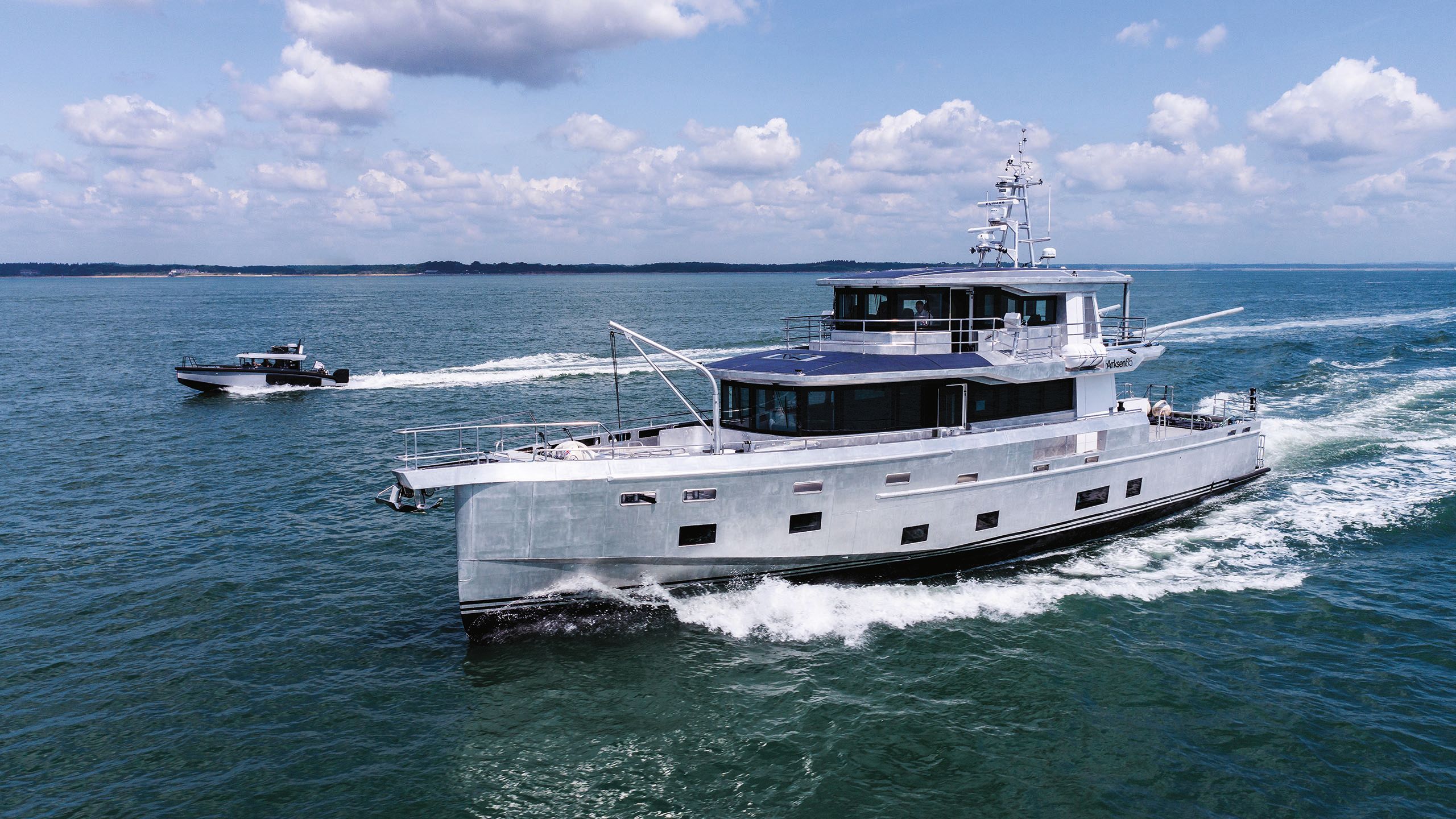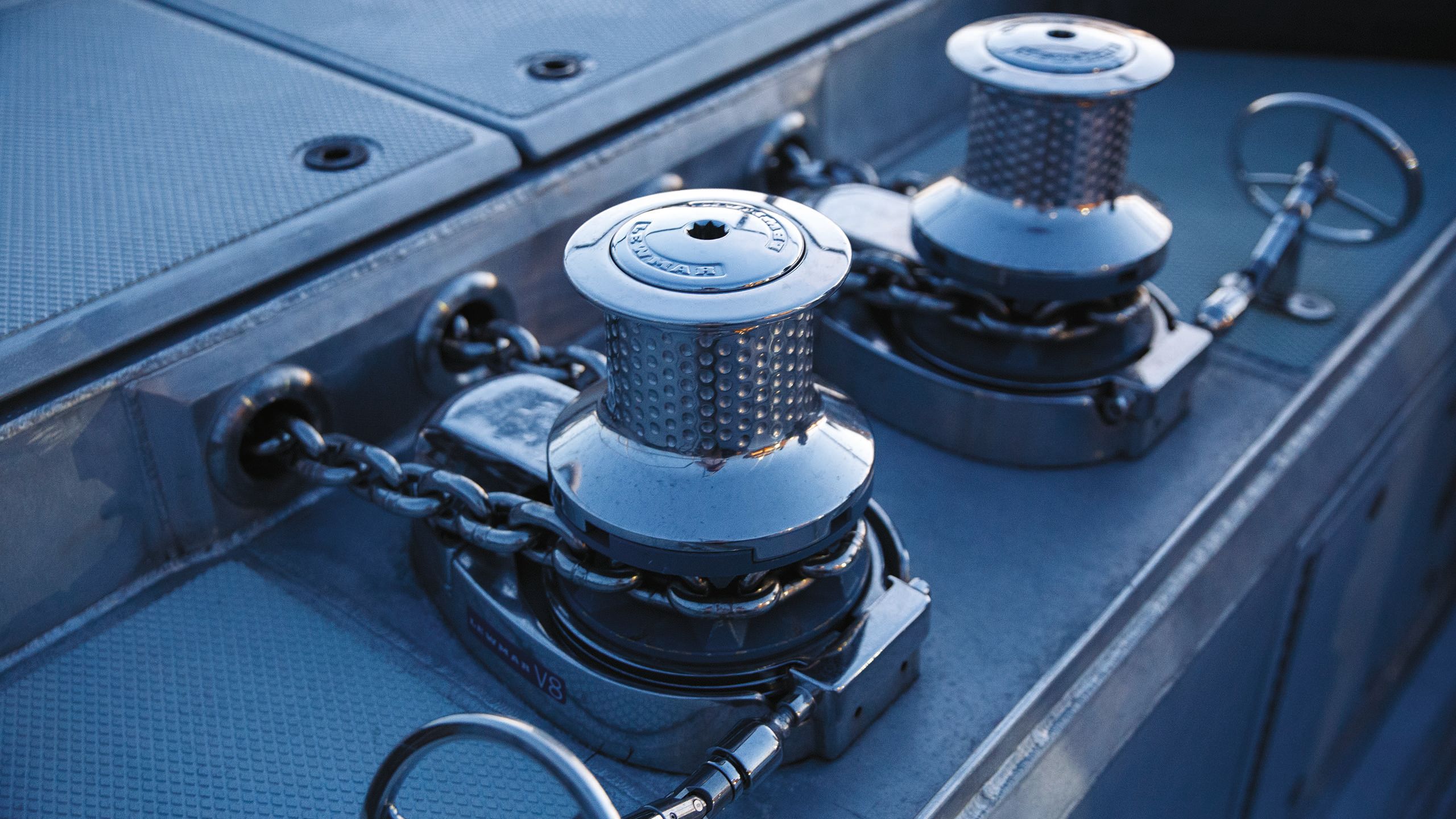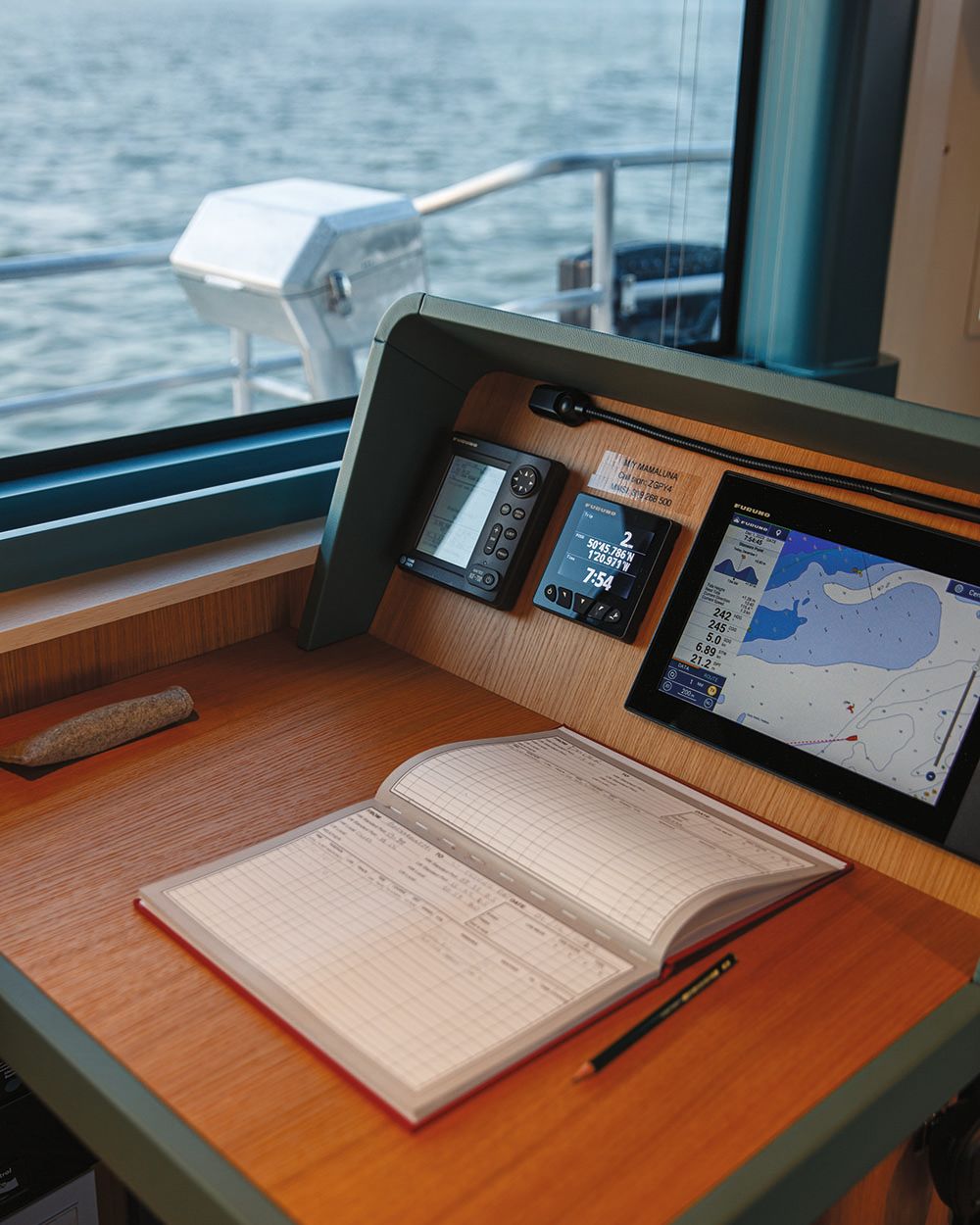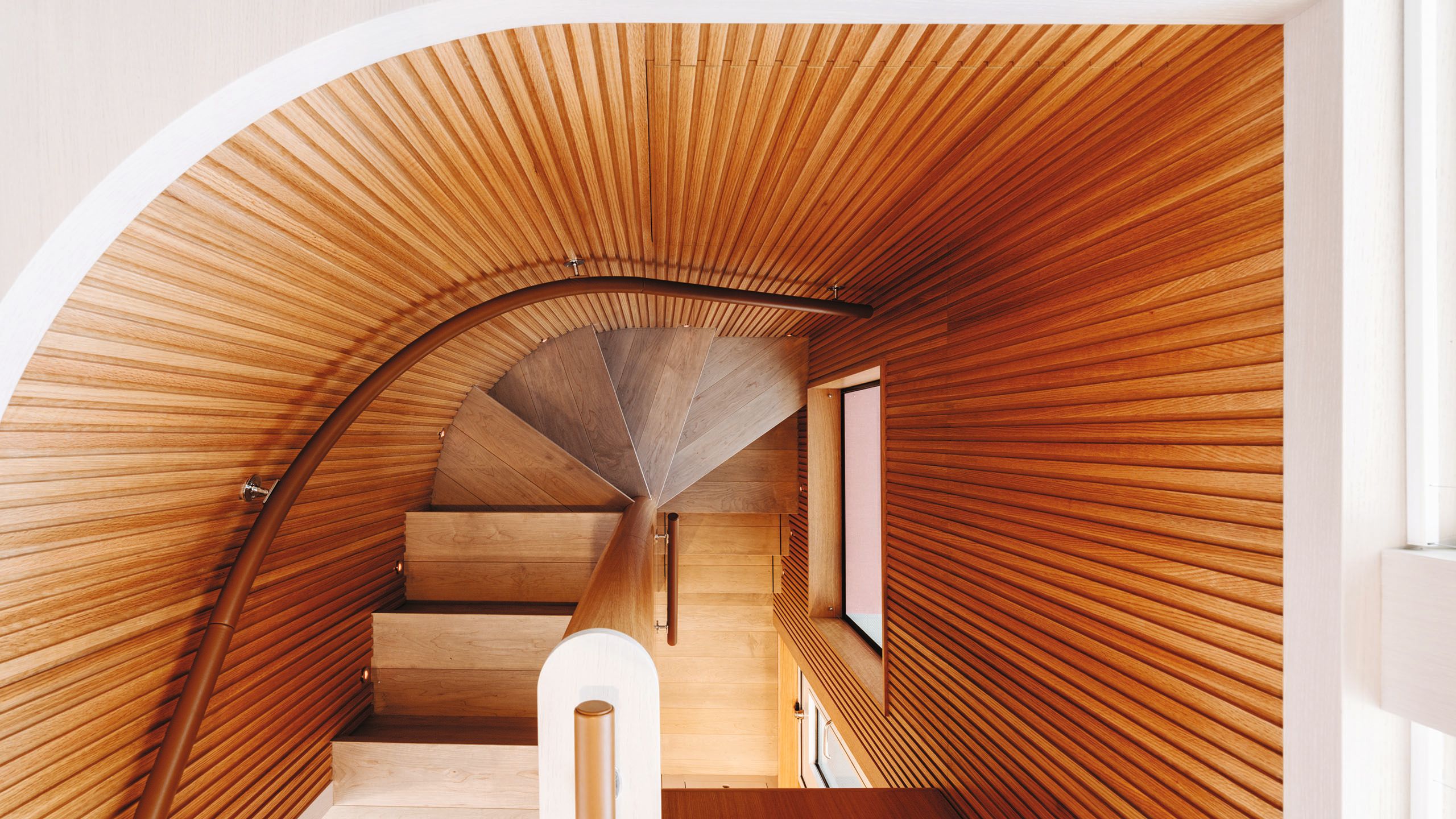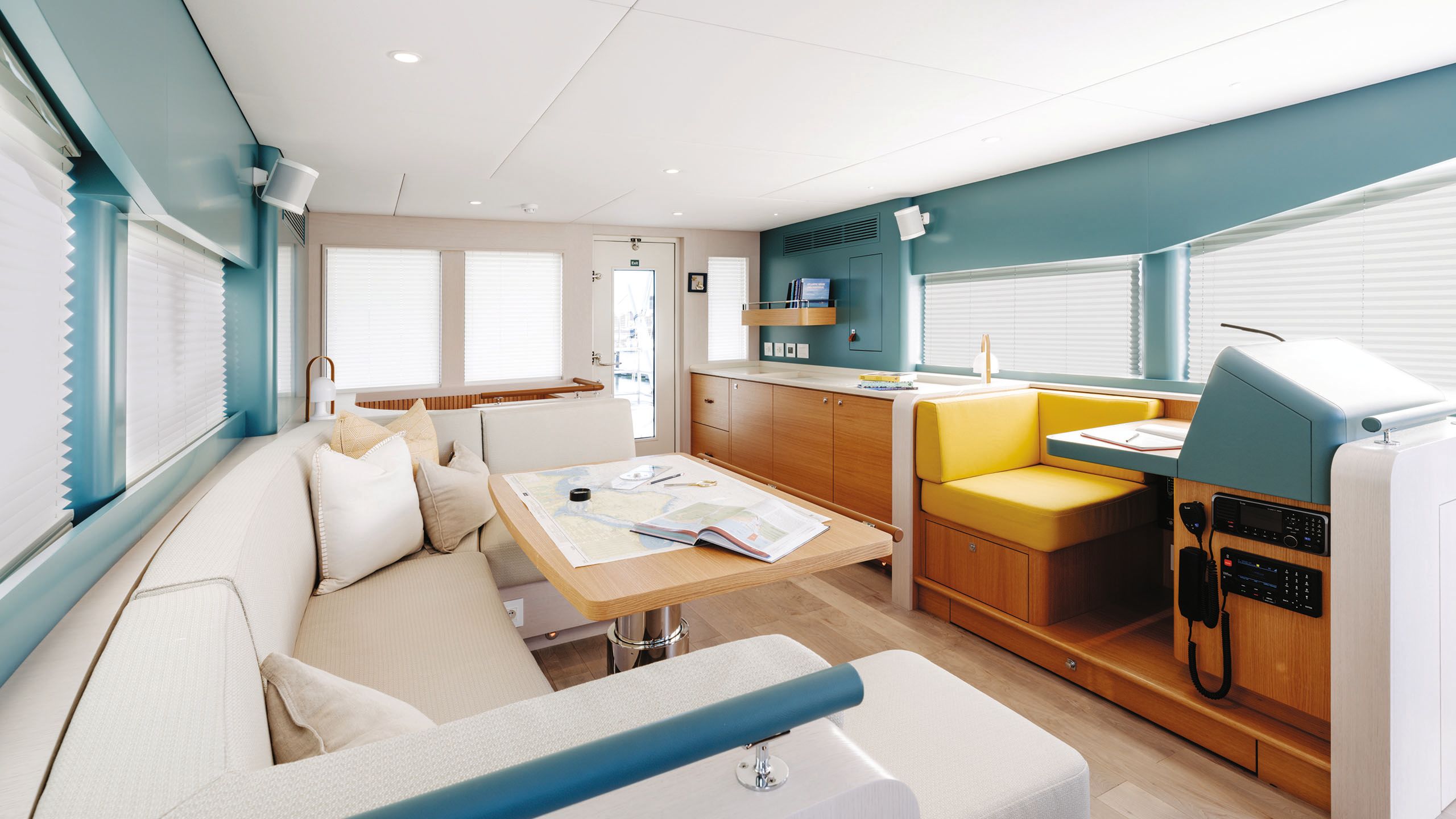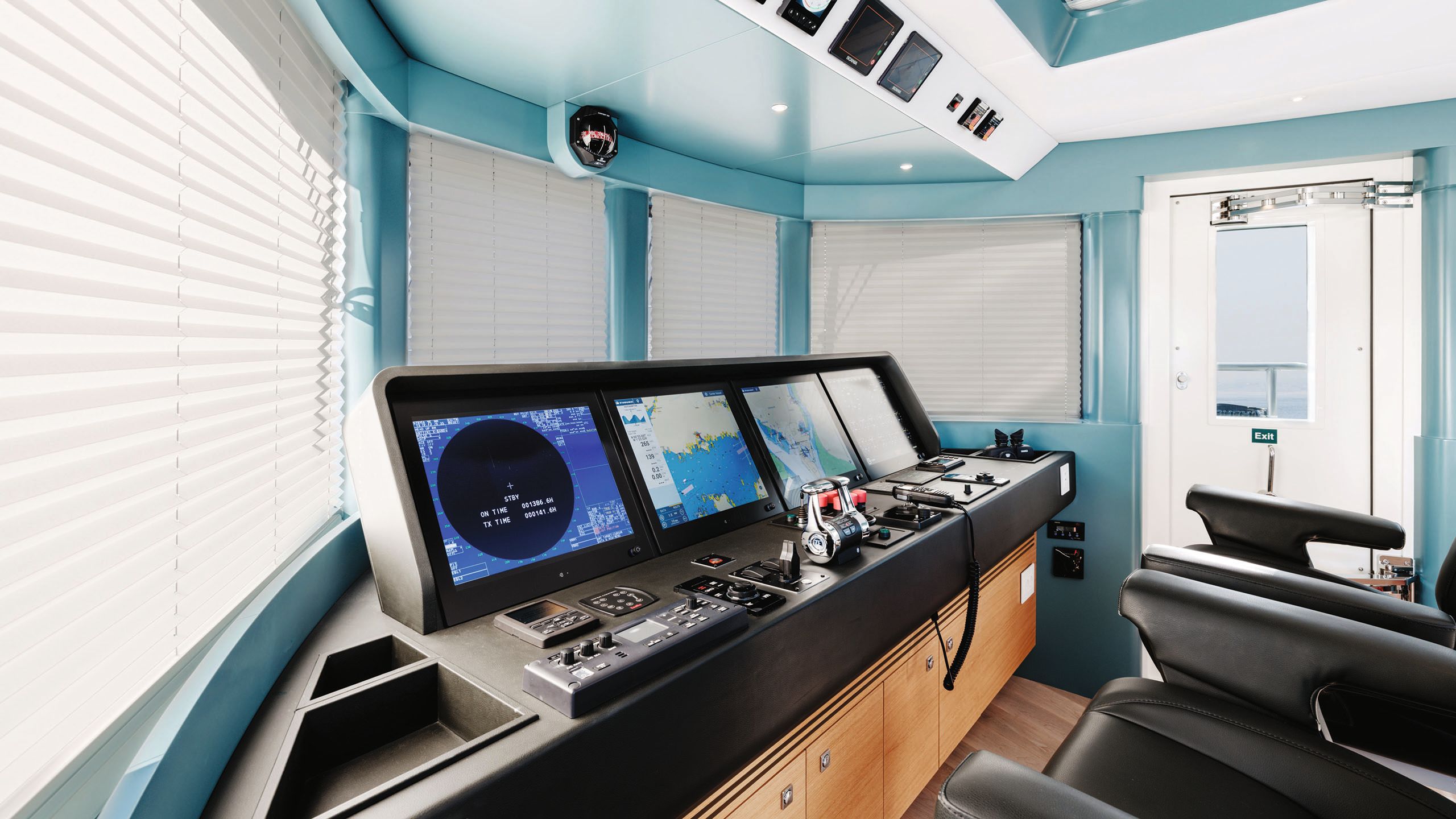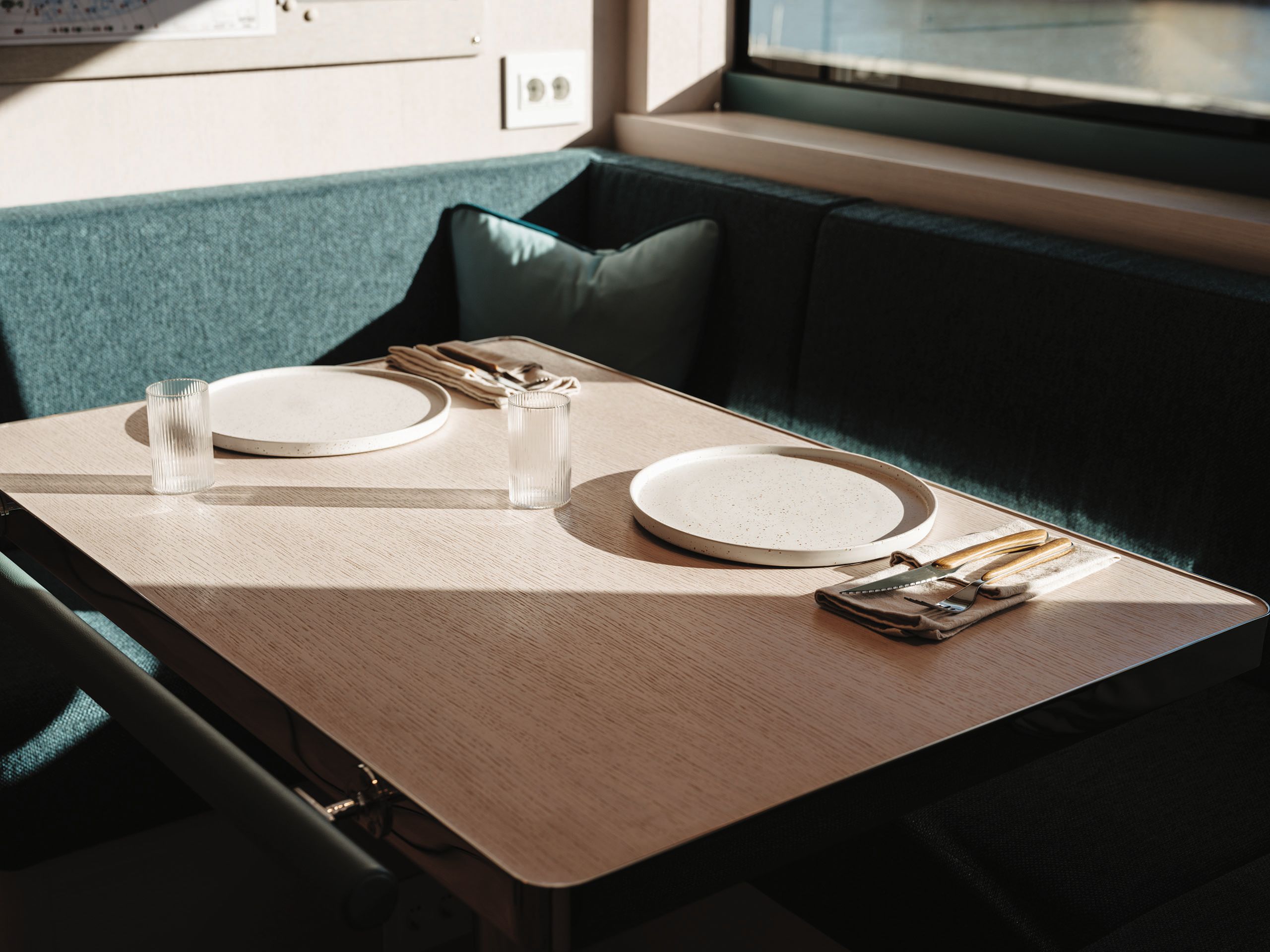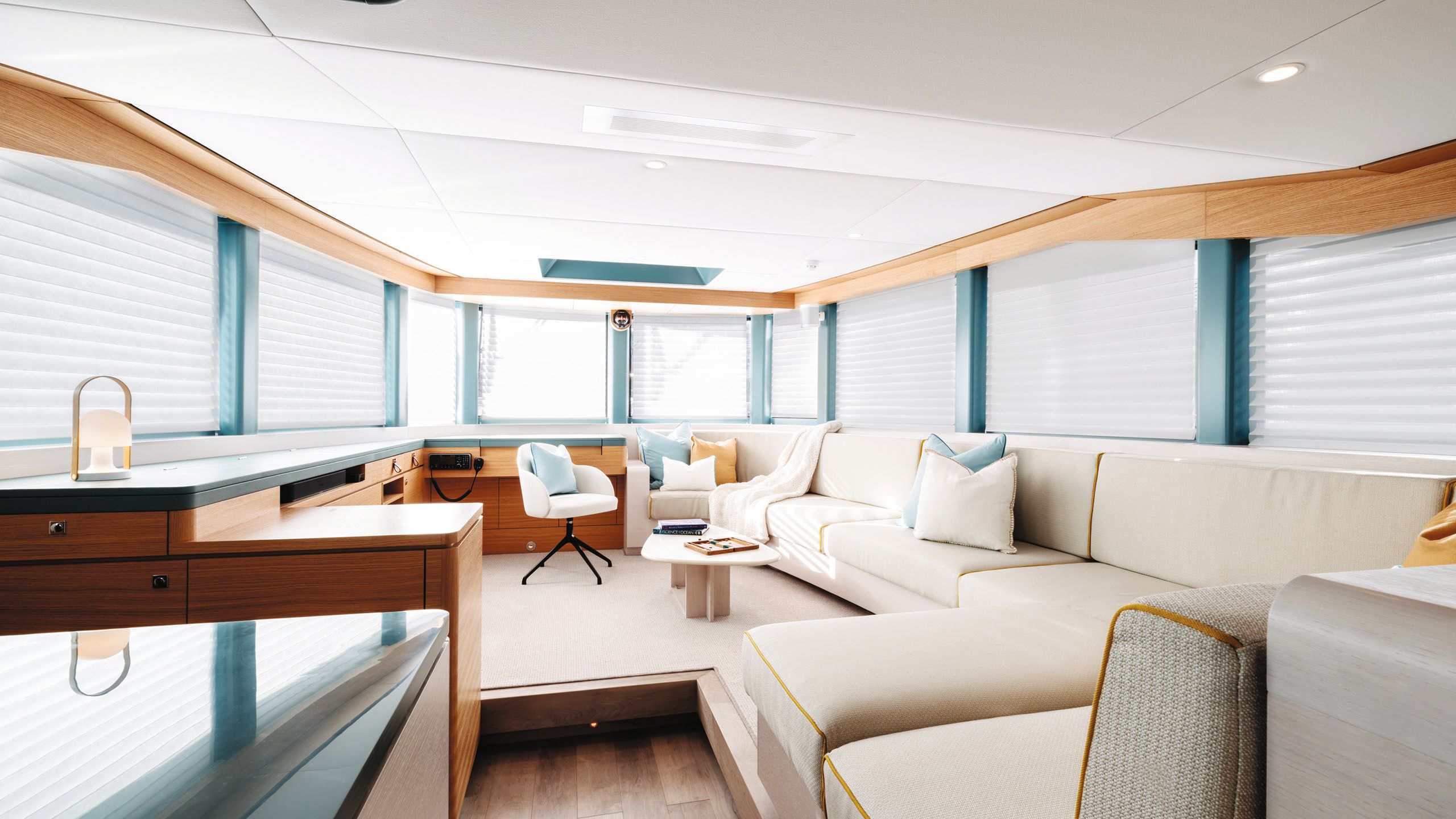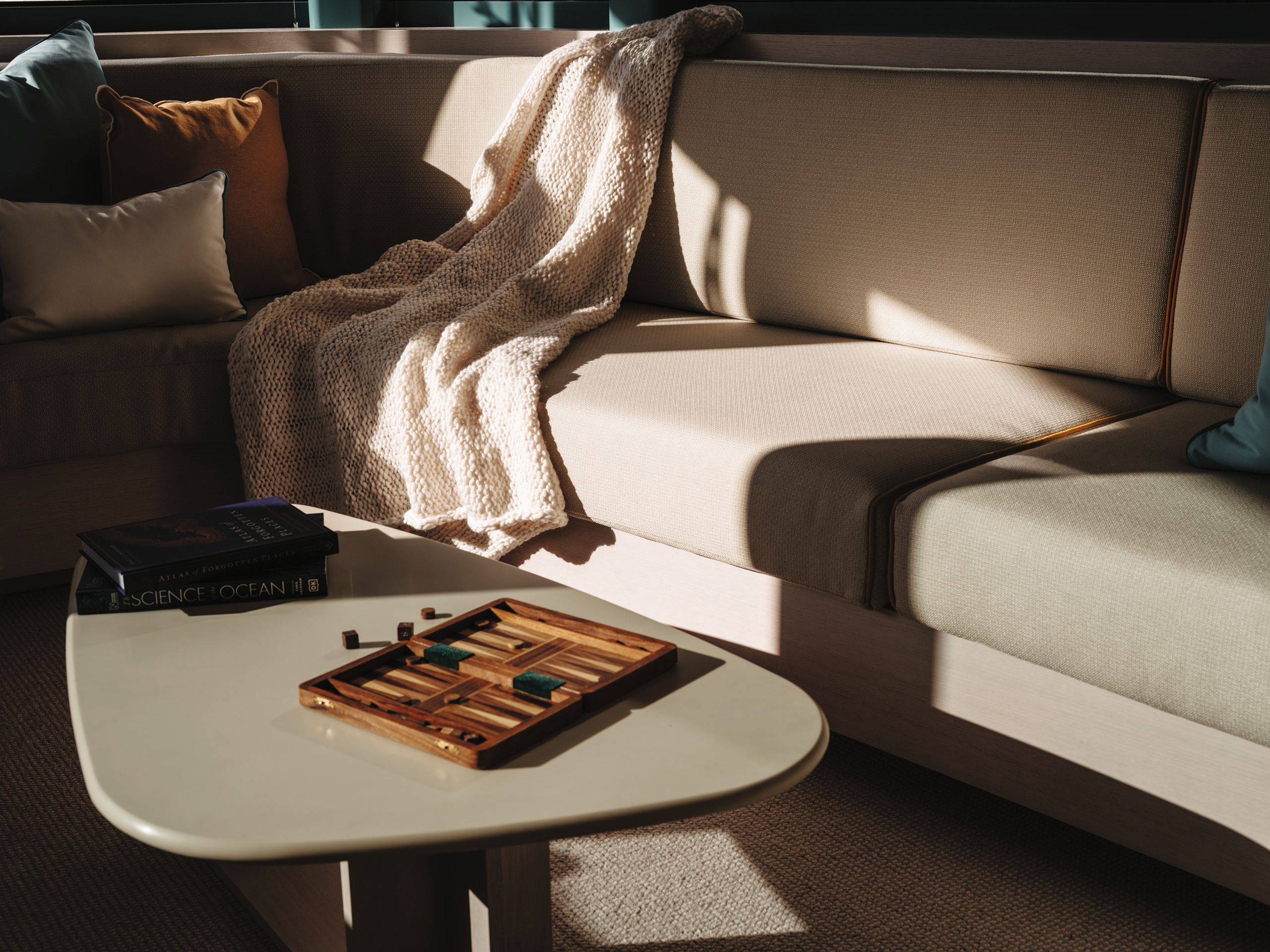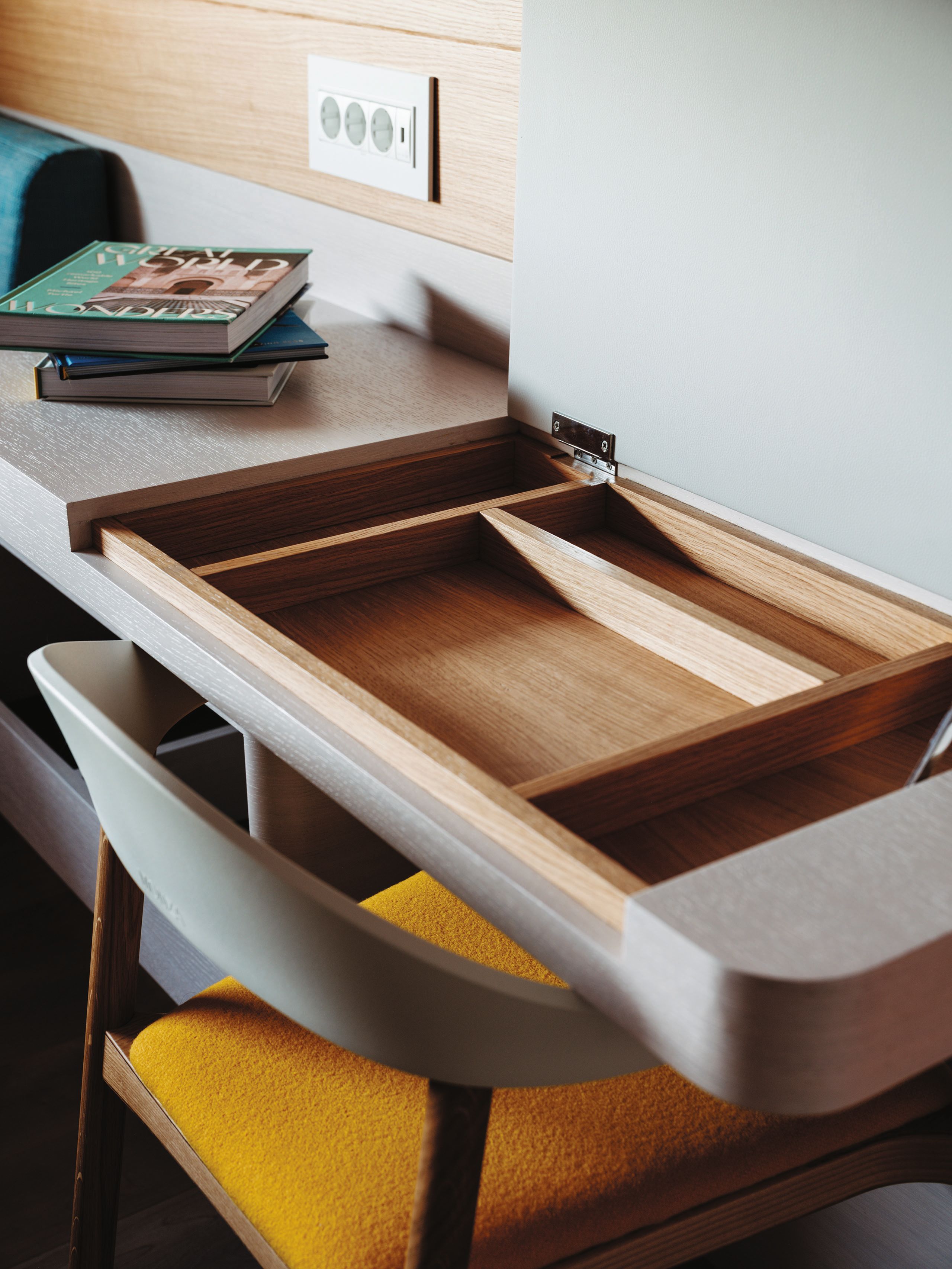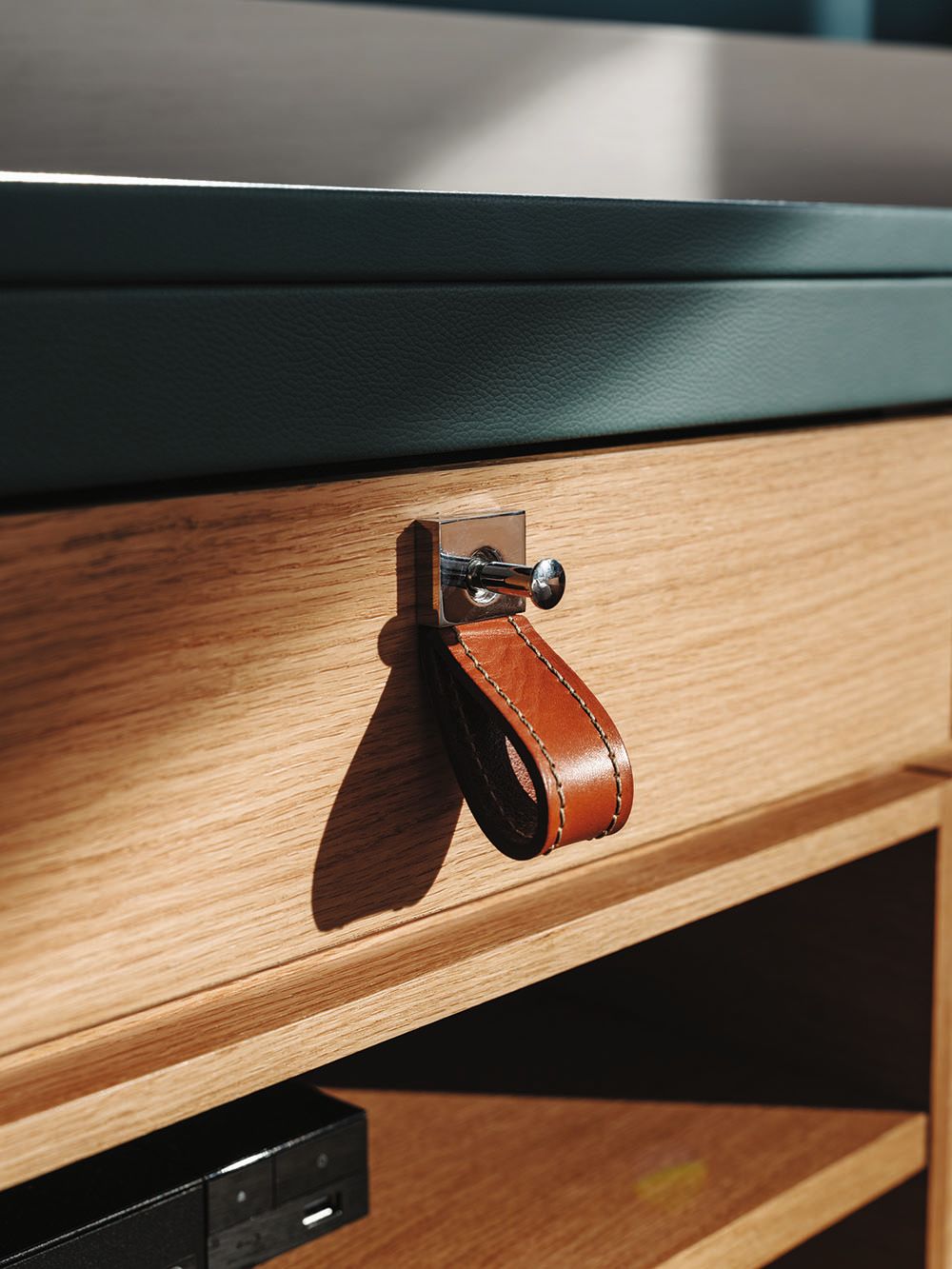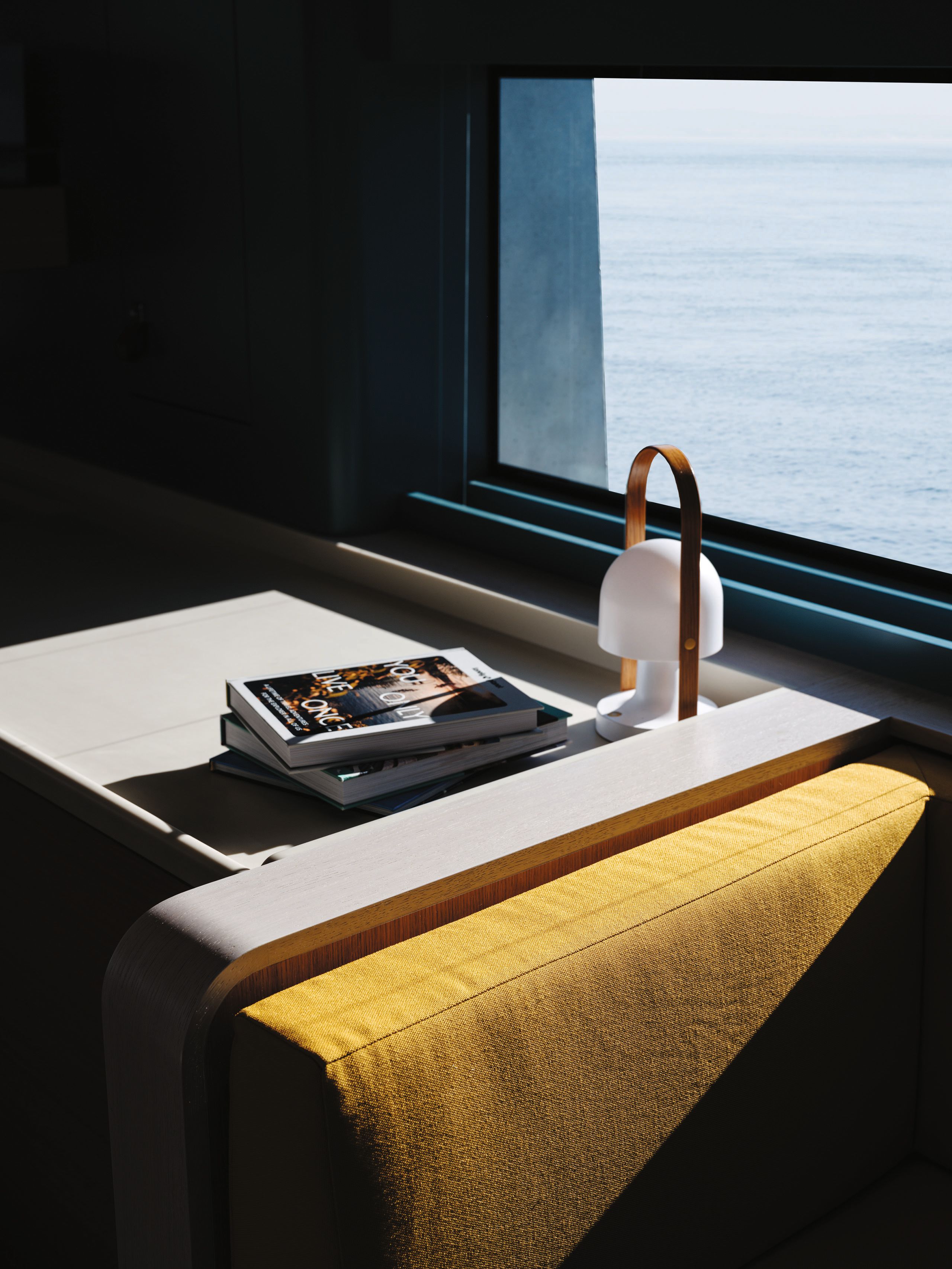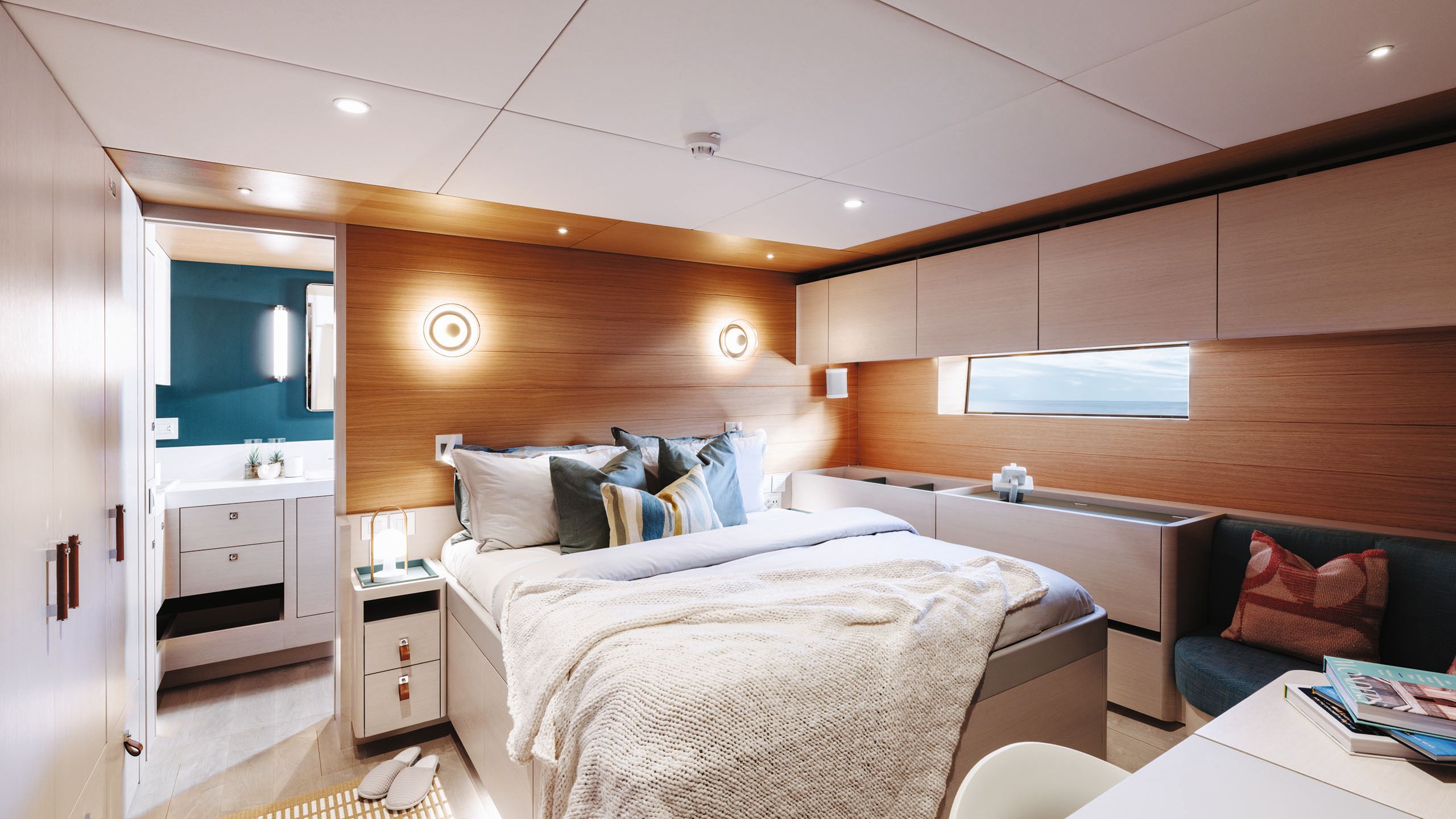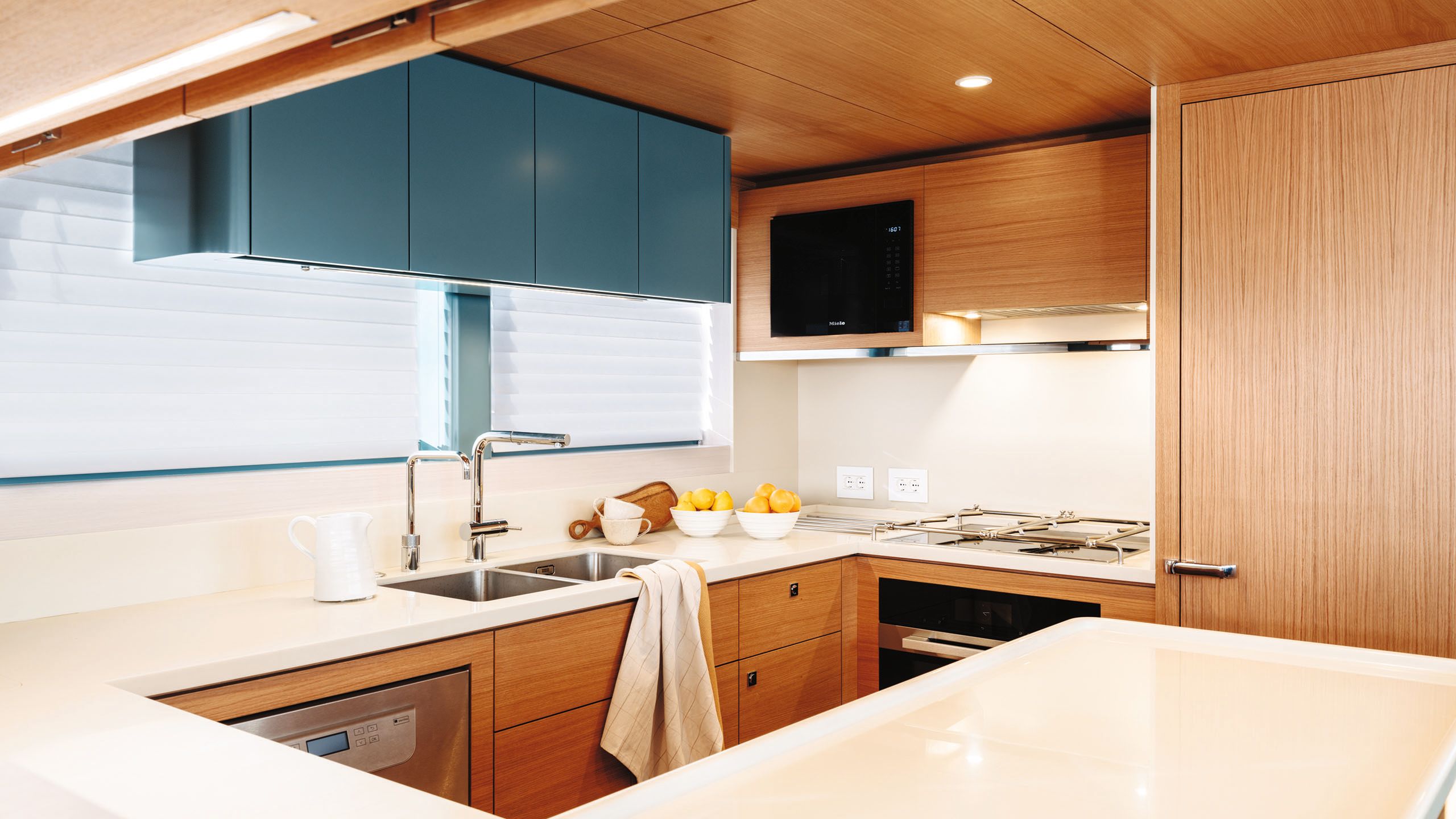ARKSEN 85
On board the low-maintenance pocket explorer that’s high on sustainability
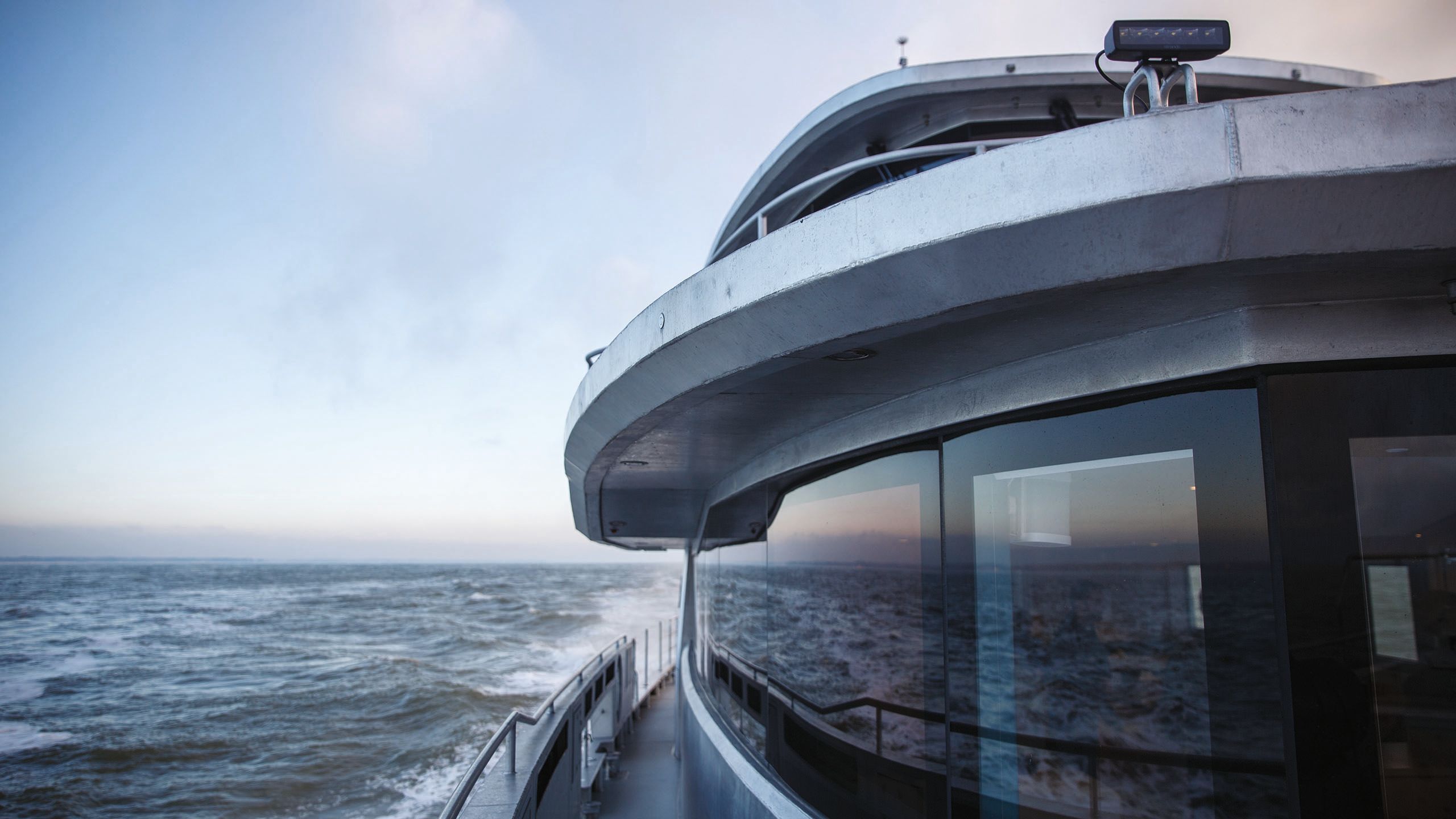
Robust and recyclable, streamlined and stripped back – the Arksen is a truly sustainable and practical explorer, as Risa Merl discovers
ARKSEN
“We argued for 15 years and over 80,000 miles about what the ultimate explorer boat would be, ”says Arksen founder Jasper Smith. Long before the adventure yacht builder set up shop in 2017, Smith co-owned a yacht that embarked on a world-girding cruising program.
During this time, the owners mulled over what they’d do differently if they could design their own yacht. While moored off the coast of Greenland, Smith decided to make the musings a reality and create a new breed of explorer yacht. The result is the 27.3-metre Arksen 85, an explorer that puts a priority on low maintenance, high efficiency and real sustainability.
ARKSENThe unfinished aluminium exterior will patina nicely over time. Much like a commercial vessel, the Arksen 85 boasts wide side decks with hidden storage in the bulwarks
ARKSENThe unfinished aluminium exterior will patina nicely over time. Much like a commercial vessel, the Arksen 85 boasts wide side decks with hidden storage in the bulwarks
“We demanded a few core things,” says Smith, “true capability with up to three months autonomy at sea, a long range without the need for frequent refuelling or maintenance stops, space for adventure gear, silent running capability, always-on comms, hybrid propulsion and large solar capacity, and, of course, excellent seakeeping with a very shallow draught and skegs so that she could be beached if needed.”
The vessel should be able to handle the most demanding adventures safely, such as navigating icy waters or drying out on tropical beaches for mid-voyage maintenance.
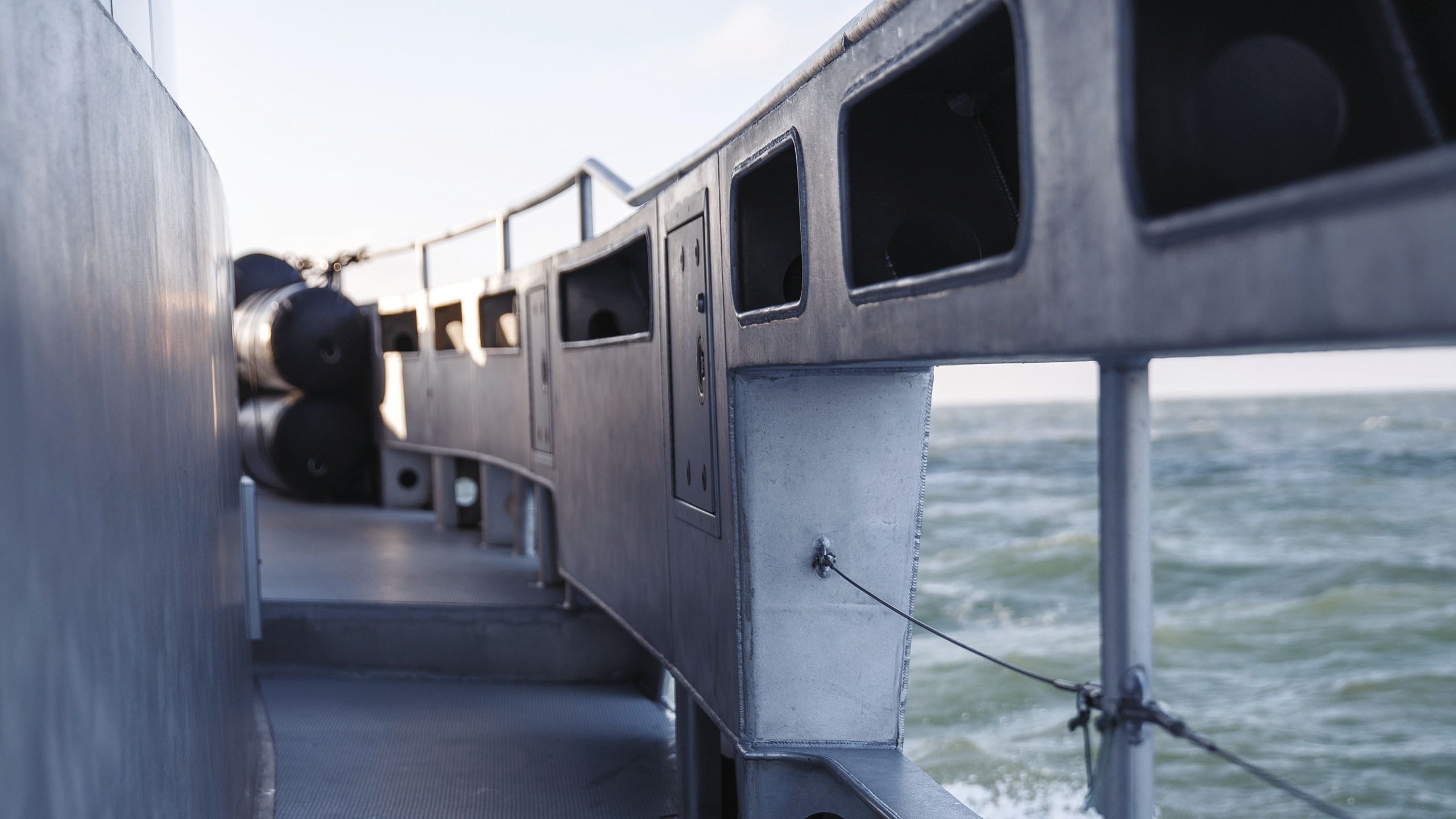
“The owner of Project Pelagos wanted the exterior to patina over time,” explains Arksen’s delivery captain Ben Bowley. Another option is to paint the hull, but the filling and fairing would add a little weight, changing the efficiency of the vessel. “And it would require more maintenance.” The choice to celebrate the exposed metal highlights the Arksen 85’s intended purpose as a hardy explorer.
Aluminium was chosen for its lightweight, robust and longlasting properties. It’s also easy to maintain and repair in far-flung locales if no shipyards are in sight, and the material’s recyclability ensures that the vessel is environmentally responsible at the end of its life cycle.
“One of the reasons we chose aluminium is that it’s infinitely recyclable,” says Jim Mair, Arksen’s technical director. The Arksen 85 is also constructed using a Speira aluminium that is more than 40 per cent recycled. “The next boat will have 70 per cent recycled aluminium,” Mair adds.
The Explorer Yachts Summit
The Explorer Yachts Summit is held annually at the Yacht Club de Monaco and is the only international summit dedicated solely to the explorer yachting sector.

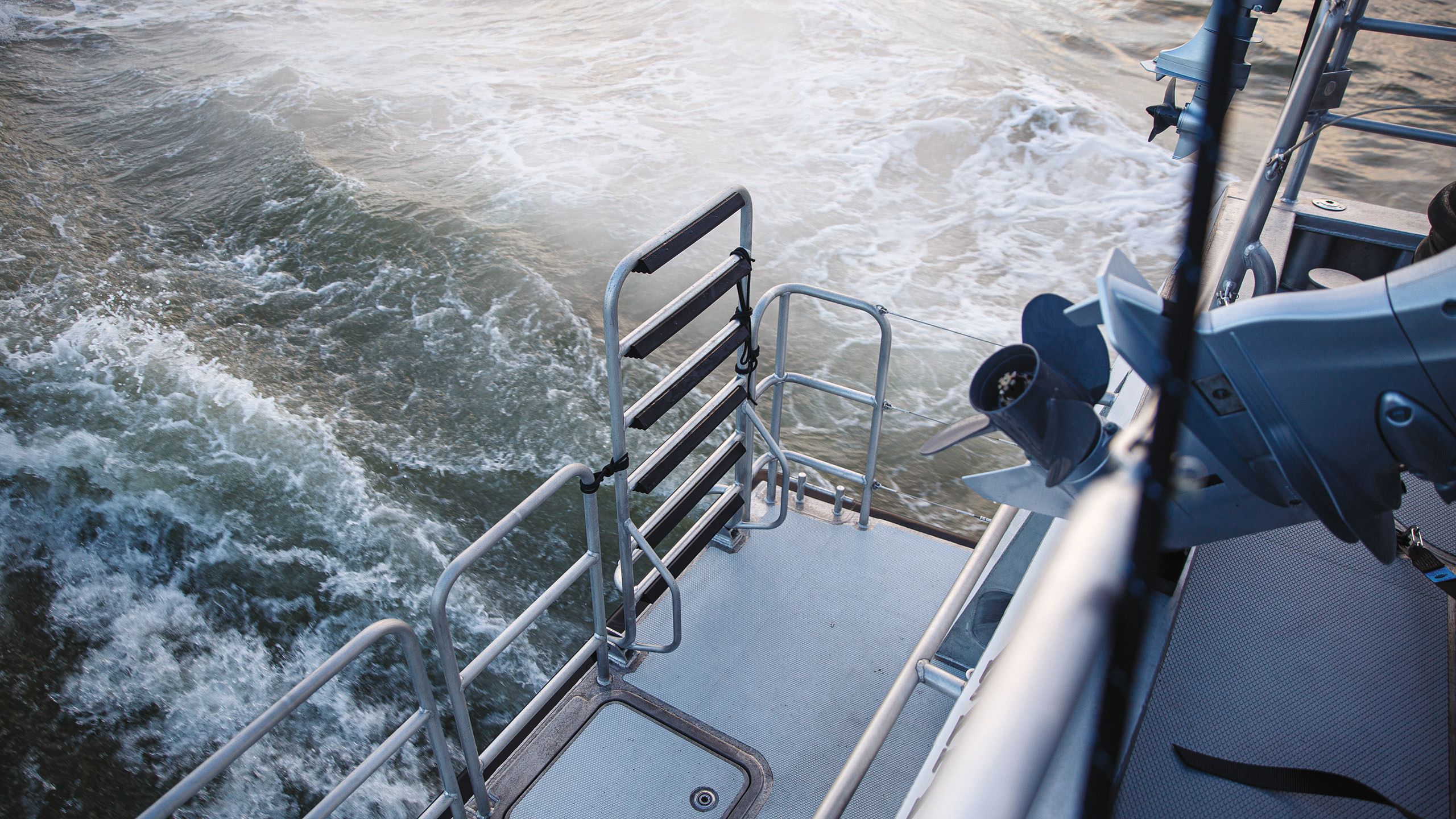
The Arksen 85’s intentionally rough-and-ready appearance belies the painstaking attention to her details. Absolutely nothing is overlooked, from over-specced and redundant systems to a structural design that exceeds the Lloyd’s rule requirements for the vessel’s size, all of which is intended to provide additional reliability for remote cruising and challenging conditions.
ARKSEN Much like a commercial vessel, the Arksen 85 boasts heavy-duty winches
ARKSEN Much like a commercial vessel, the Arksen 85 boasts heavy-duty winches
“I like the saying ‘two is one and one is none’, so everything that’s critical is redundant,” Mair says, listing off items in pairs, such as the watermakers, generators and steering systems. It’s a level of redundancy that might be expected in a much larger superyacht but will be greatly appreciated by crew in a pocket explorer.
One of the aspects of the Arksen 85 that Smith is most proud of is the quality of engineering. “The pipe runs are a work of art, all pre-bent metal pipe in an intricate network, running like veins and ventricles throughout,” he says. “It’s the bits that you cannot see that I love the most.”
ARKSEN
ARKSEN
To bring his vision for the Arksen Explorer Series to life, Smith called on two experienced British design houses: Humphreys Yacht Design penned the exterior, hull form and general arrangement, while Design Unlimited created the interior decor and worked with Humphreys on augmenting the arrangement per each client’s request.
Much like a sailing yacht, if she were to roll in
rough seas she'd be able to flip back over.
The glazing had to be made especially durable
to afford this; as such the windows
are 25 millimetres thick
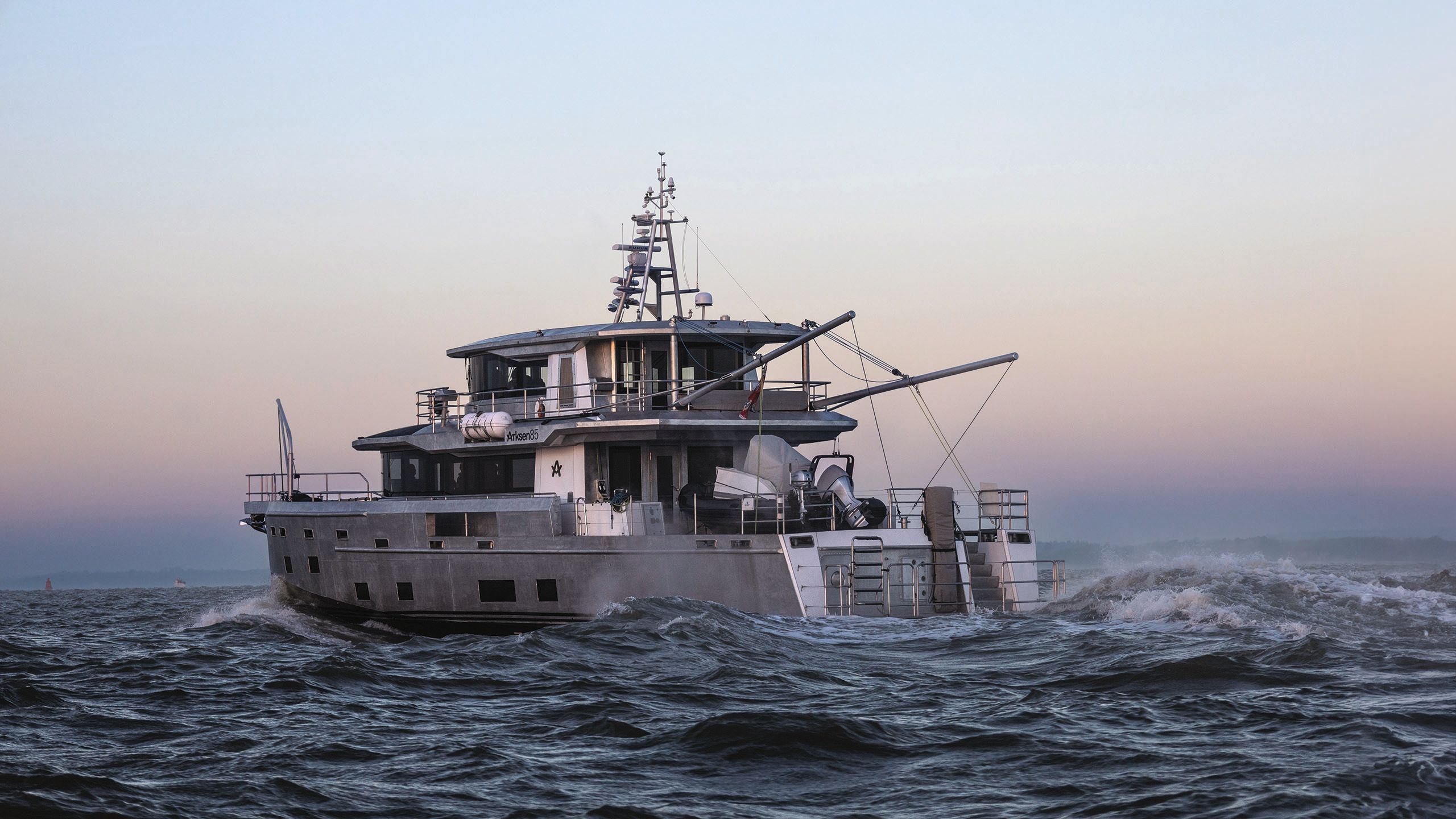
ARKSEN
ARKSEN
Humphreys Yacht Design was involved from the conceptual stages. Smith gave a lofty brief to the designers, requesting that the Arksen 85 have: “The autonomy of a Tesla, the robustness of a Caterpillar engine, the elegance of a Rolls-Royce, the spine of a high-altitude K2 mountaineer and the romance and silence of a free diver, wrapped in an engineering envelope that delivers efficiency and range.”
It was a tall order, but the designers were up to the challenge. “We bought into the ethos of what Jasper [Smith] wanted to create,” says Tom Humphreys, director and co-owner of Humphreys Yacht Design, who worked on the project alongside his father, studio founder Rob Humphreys.
Humphreys Yacht Design was involved from the conceptual stages. Smith gave a lofty brief to the designers, requesting that the Arksen 85 have: “The autonomy of a Tesla, the robustness of a Caterpillar engine, the elegance of a Rolls-Royce, the spine of a high-altitude K2 mountaineer and the romance and silence of a free diver, wrapped in an engineering envelope that delivers efficiency and range.”
Much like a sailing yacht, if she were to roll in rough seas she'd be able to flip back over. The glazing had to be made especially durable to afford this; as such the windows are 25 millimetres thick
It was a tall order, but the designers were up to the challenge. “We bought into the ethos of what Jasper [Smith] wanted to create,” says Tom Humphreys, director and co-owner of Humphreys Yacht Design, who worked on the project alongside his father, studio founder Rob Humphreys.
ARKSENThe whitewashed oak, ribbed staircase and Scandi-inspired interior is made bolder by pops of colour as seen in the teal and yellow furnishings
ARKSENThe whitewashed oak, ribbed staircase and Scandi-inspired interior is made bolder by pops of colour as seen in the teal and yellow furnishings
“What really differentiates the Arksen from other explorer yachts and trawlers is the much higher efficiency and lower fuel consumption,” says Rob Humphreys of the yacht’s 7,000-nauticalmile range and fuel consumption of 120 litres per hour at 14 knots.
The Arksen 85’s narrow, fast-displacement hull seems closer to a sailing yacht than a traditional displacement boat. Perhaps it’s no surprise, since part of Humphreys Yacht Design’s modus operandi is calling on its deep experience in sailing boat design and applying that to a motor yacht.
ARKSEN
ARKSEN
The upper deck saloon has a dining table
Because the yacht had to be efficient as well as offer immense seakeeping, the Humphreys Yacht Design team used CFD analysis and tank testing to refine the hull form and get the balance just right. “The hull is slippery with low drag, but nicely controlled and has good stability,” says Rob Humphreys.
There’s also a fairly generous rudder area to maintain control in high-speed surfing situations. “We knew from tank testing that in big ocean swells, the boat would surf down the waves,” says Tom Humphreys. The designers also developed systems for controlling trim, such as carrying extra water in the freshwater tanks.
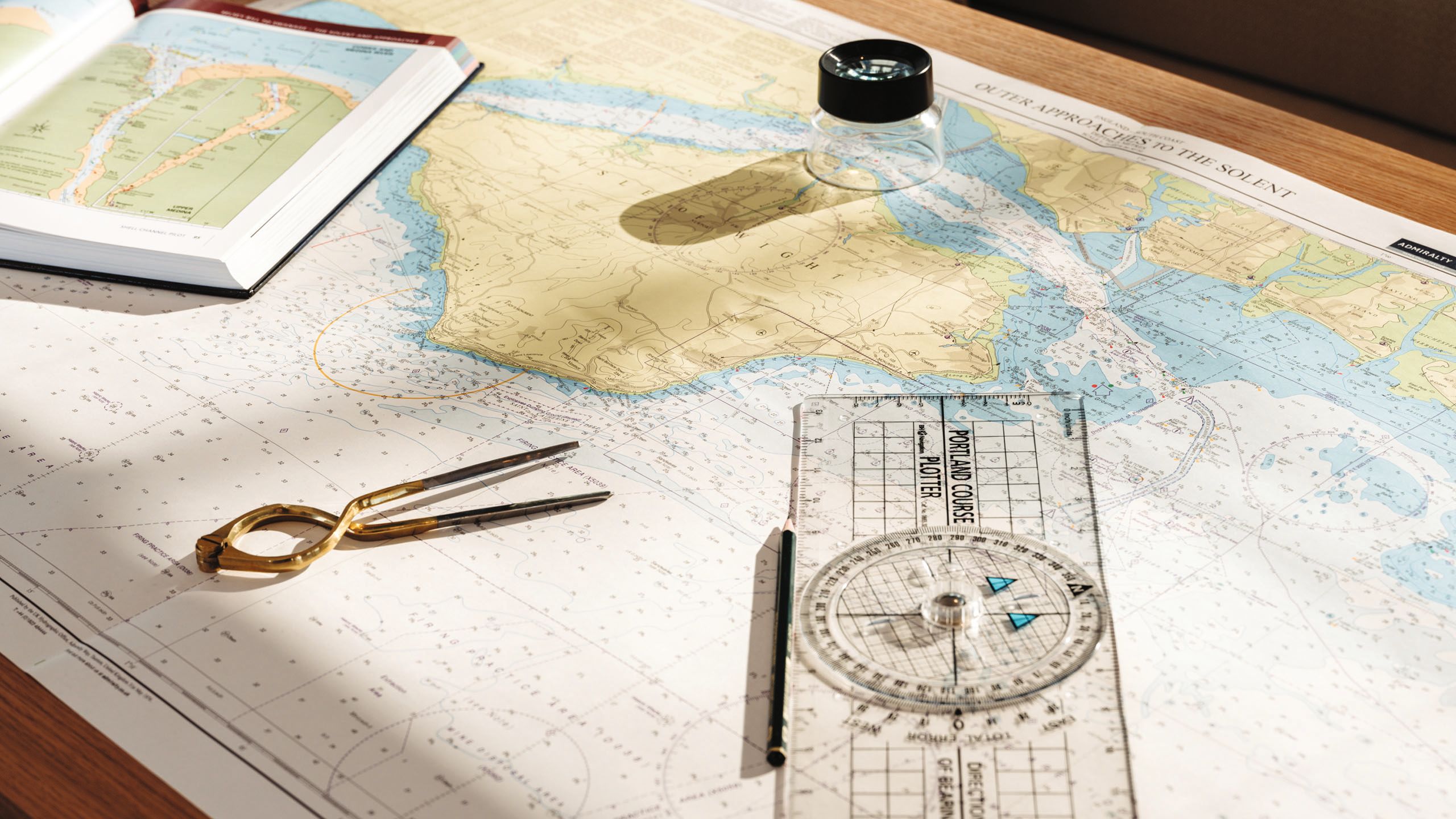
The hull is designed to mimic the roll of a displacement yacht thanks to its stabilisation, with Humphree Fins and interceptors. Another means of passive stabilisation is the “flopper stoppers” – hinged stainless-steel plates that hang off the booms and open flat in the water to help dampen roll by up to 60 per cent. “You see a similar thing in fishing trawlers,” says Mair, noting that the booms do double duty by helping to lift and launch the tenders.
In the “nice to have but hope never to use” category is the Arksen 85’s self-righting ability. Much like a sailing yacht, if she were to roll in rough seas she’d be able to flip back over. The glazing had to be made especially durable to afford this, and as such the windows are 25 millimetres thick.
ARKSENEven the bridge is adorned in the yacht’s trademark shade of teal
ARKSENEven the bridge is adorned in the yacht’s trademark shade of teal
Eyebrow overhangs over the glazing, a walkaround Portuguese bridge and outrigger booms lend a commercial element to the yacht’s exterior.
“We concurred from the beginning on the rugged styling,” says Rob Humphreys. “I like the honesty of it. It’s form meets function, but proof that function doesn’t have to be ugly. Owners can keep a low profile but have the comforts of a superyacht inside. And, for its size, the boat packs in a lot of capabilities.”
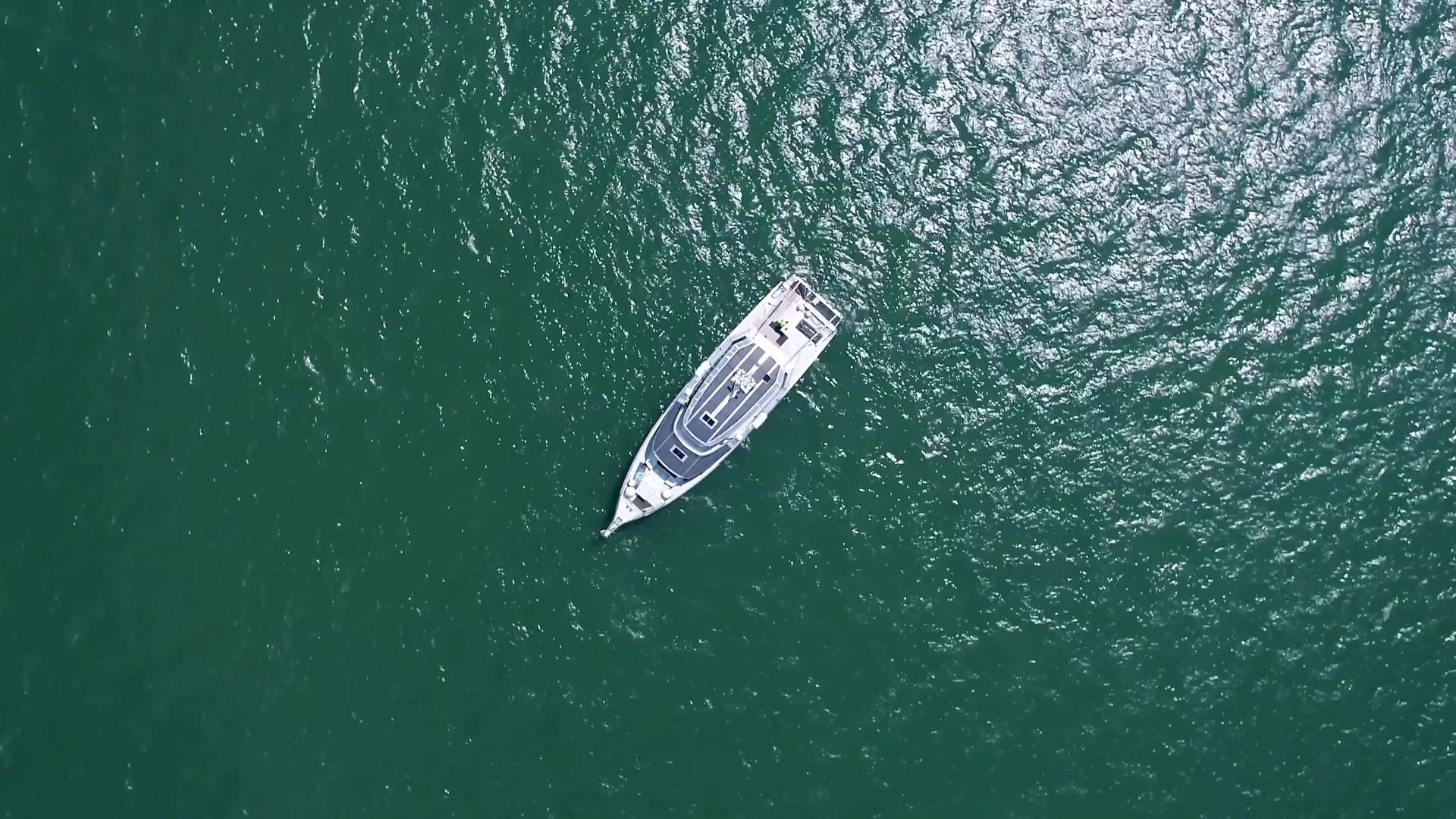
Beneath her workaday exterior, the Arksen 85 hides a comfortable superyacht interior. It was important to Smith that the Arksen 85 felt like a home. Design Unlimited created three interior schemes that vary in colour, and the one chosen by the owner of Project Pelagos features white-washed oak and teal soft goods.
ARKSEN
ARKSEN
“The interior is quite Scandinavian, stripped back with simple geometry, but the colour palette is bolder,” says Nigel Jones, senior designer at Design Unlimited. “The owner had a big say in the interior – we went through five or six different samples to get just the right shade of teal.”
ARKSEN
ARKSEN
The main saloon is designed for lounging
To meet Arksen’s overall brief for sustainability, eco-friendly materials were chosen as much as possible. This includes the pure paper laminate seen in the bathroom bulkheads, the sustainable leather found in the helm area upholstery, sustainable faux leather in the berth surrounds, and recycled PET upholstery in the armchairs and main-deck sofa.
ARKSEN
ARKSEN
Expect to see even more sustainable materials on future boats in the series, says Sophie Porteous, senior designer with Design Unlimited. “When we first started with Arksen, there was very little choice in sustainable and recyclable materials. But the market has exploded and now all of the fabric houses have an eco-friendly range.”
ARKSEN
ARKSEN
ARKSEN
ARKSEN
ARKSEN
ARKSEN
Little details, like the leather drawer pulls (centre), add to this sense of refinement
Design Unlimited called on the firm’s background in sailing yacht design to maximise accommodation and storage on board.
The GA is highly flexible, allowing for owners to further optimise the space to meet their needs, including some scope to change the layout, such as going down to three cabins instead of four or five, and to use the rooms for different purposes depending on the owner’s needs. “A good example is boat one has an office/ library area but in boat two it becomes the captain’s cabin,” says Porteous.
BEYOND BOATS
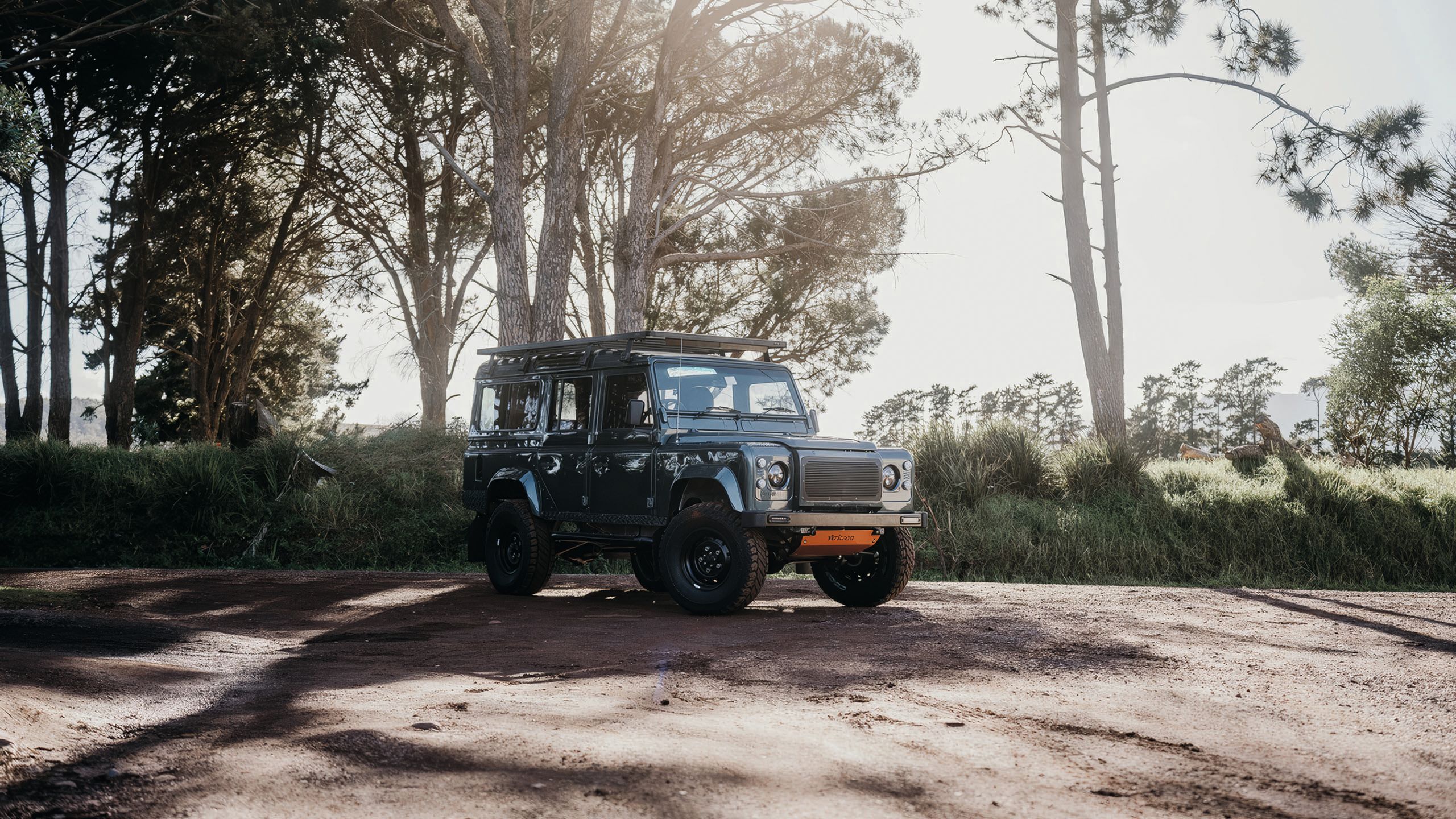
In addition to its yachts, which include the Explorer, Adventure and Discovery series of boats, Arksen has a few more offerings up its sleeve, from clothes to cars.
“We are striving to be anything but just another boatbuilder,” says Arksen founder Jasper Smith. “Our community embraces overland expeditions just as much as crossing oceans, and many of them are interested in scaling high mountains or backcountry skiing in remote areas.”
The Overland division retrofits four-wheel drive vehicles, such as the Arksen D110e electric Land Rover Defender, which offers fast-charging, a 240km range, a 240V inverter and curated Arksen specs.
As part of the wider lifestyle adventure brand, the company also launched its apparel label, Arksen Labs, which uses sustainable materials to create waterproof jackets and tech T-shirts.
Finally, Arksen is also getting into the adventure travel game. “Arksen Adventures, which we launched recently and augmented through acquisition, will be the world’s largest provider of adventure sailing holidays,” says Smith.
“It will also offer a wide range of carefully curated and potentially life-changing experiences, taking in mountains, deserts and oceans. “Our aim is to unite conservation, adventure and epic products to create a new type of adventure company built for a new generation of explorers,” Smith continues. “We realise that this radical approach is not for everyone. But that’s a good thing.”
In addition to its yachts, which include the Explorer, Adventure and Discovery series of boats, Arksen has a few more offerings up its sleeve, from clothes to cars. “We are striving to be anything but just another boatbuilder,” says Arksen founder Jasper Smith. “Our community embraces overland expeditions just as much as crossing oceans, and many of them are interested in scaling high mountains or backcountry skiing in remote areas.”
The Overland division retrofits four-wheel drive vehicles, such as the Arksen D110e electric Land Rover Defender, which offers fast-charging, a 240km range, a 240V inverter and curated Arksen specs. As part of the wider lifestyle adventure brand, the company also launched its apparel label, Arksen Labs, which uses sustainable materials to create waterproof jackets and tech T-shirts.
Finally, Arksen is also getting into the adventure travel game. “Arksen Adventures, which we launched recently and augmented through acquisition, will be the world’s largest provider of adventure sailing holidays,” says Smith.
“It will also offer a wide range of carefully curated and potentially life-changing experiences, taking in mountains, deserts and oceans. “Our aim is to unite conservation, adventure and epic products to create a new type of adventure company built for a new generation of explorers,” Smith continues. “We realise that this radical approach is not for everyone. But that’s a good thing.”
As hull No 2 is planned primarily for family use in the Med, there are more al fresco dining spaces, for example on the aft upper deck, which took away the need for a full dining room in the saloon. Instead, the main saloon of the second hull has a laid-back seating area where the family can unwind and play games.
The position of the main stairwell was also flipped between the two boats, with hull two moving it further forward. “That meant the stairwell intruded into the lower-deck guest cabin, but opened up the master cabin and made it bigger,” says Jones. This move also allowed for the open forward saloon and large galley arrangement.
ARKSENDespite her workboat exterior, the Arksen 85 has a warm and homely superyacht-grade interior
ARKSENDespite her workboat exterior, the Arksen 85 has a warm and homely superyacht-grade interior
On Smith’s wish list was a proper utility room, workshop and the ability to host scientific researchers. The Arksen 85 has large, open rear decks, perfect for storing ROVs, RIBs and film-making gear, as well as an open foredeck for stowing adventure gear like snowmobiles and enduro bikes – items that Smith describes as “essential”.
Another difference between the two boats is the propulsion system. While the owner of Project Pelagos opted for traditional diesel power, hull No 1 will use diesel-electric propulsion. Both yachts have roofs covered in solar panels capable of producing 6.5kW of energy.
ARKSENCareful space planning informed by years of experience optimising sailing yacht interiors has led to sizeable living areas for a yacht of her length, such as the galley
ARKSENCareful space planning informed by years of experience optimising sailing yacht interiors has led to sizeable living areas for a yacht of her length, such as the galley
Designed for ease of operation with minimal crew, the hull No 1 will be arranged as a two-crew-member boat for hands-on owners and guests, while in hull No 2 the crew cabins are decorated to the same level of finish as the guest spaces, so some crew cabins can be used for guests if all are not needed for crew.
“Our community are navigators, sailors and adventurers,” says Smith. “They see themselves as integral to the operation of the vessels, not as guests.”
Plans to widen Arksen’s explorer offerings are well underway, with the Arksen 65 close to launching and concepts in the works for a future 50-metre project.
Fundamentally, Smith’s goal was to create a new type of vessel for modern exploration. “A complete paradigm shift from the norm,” he says. With one-of-a-kind looks, long-range capabilities and a commitment to sustainability, it seems that the Arksen explorer range is well on its way to doing just that.
First published in the September 2024 issue of BOAT International. Get this magazine sent straight to your door, or subscribe and never miss an issue.
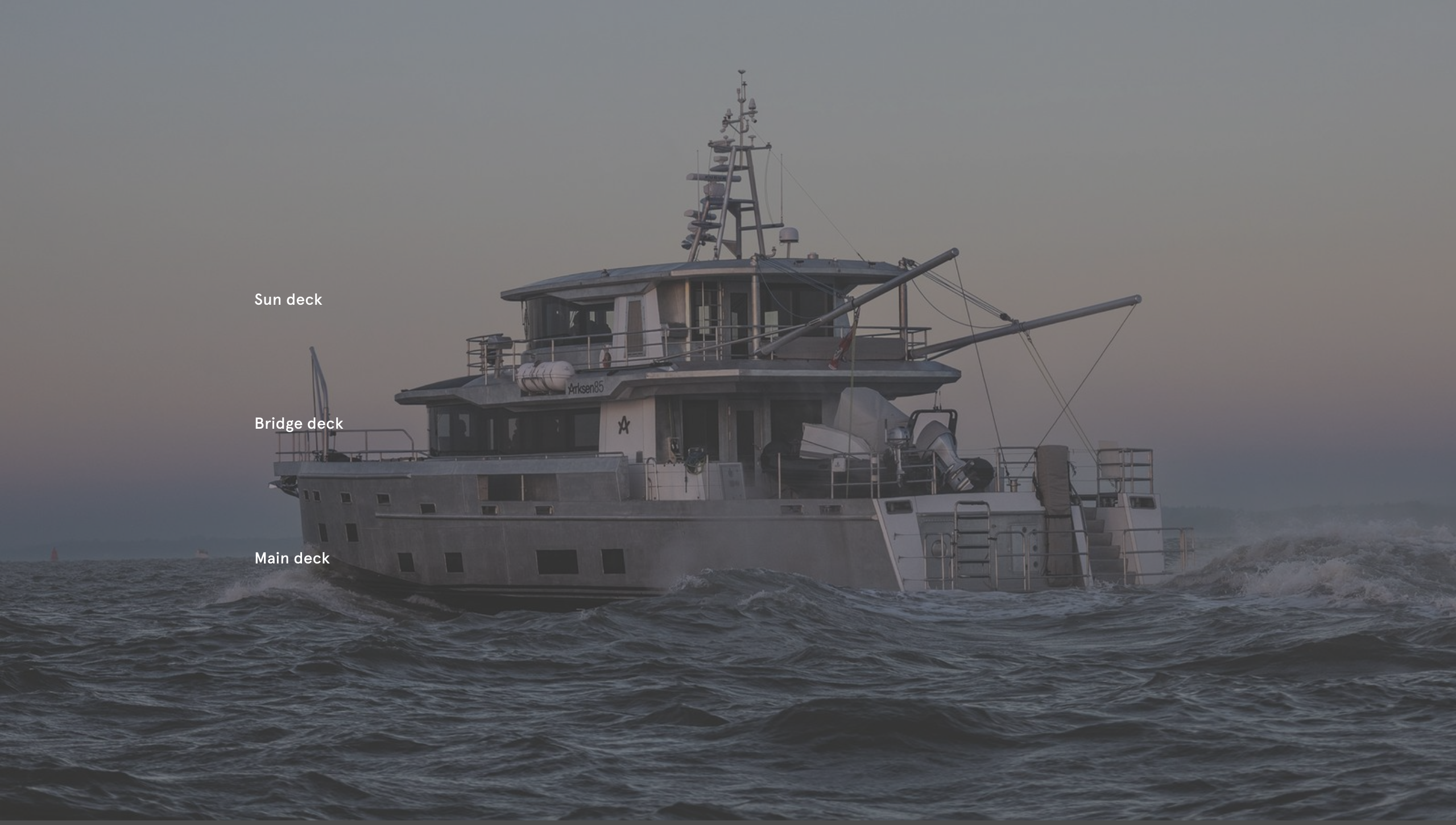
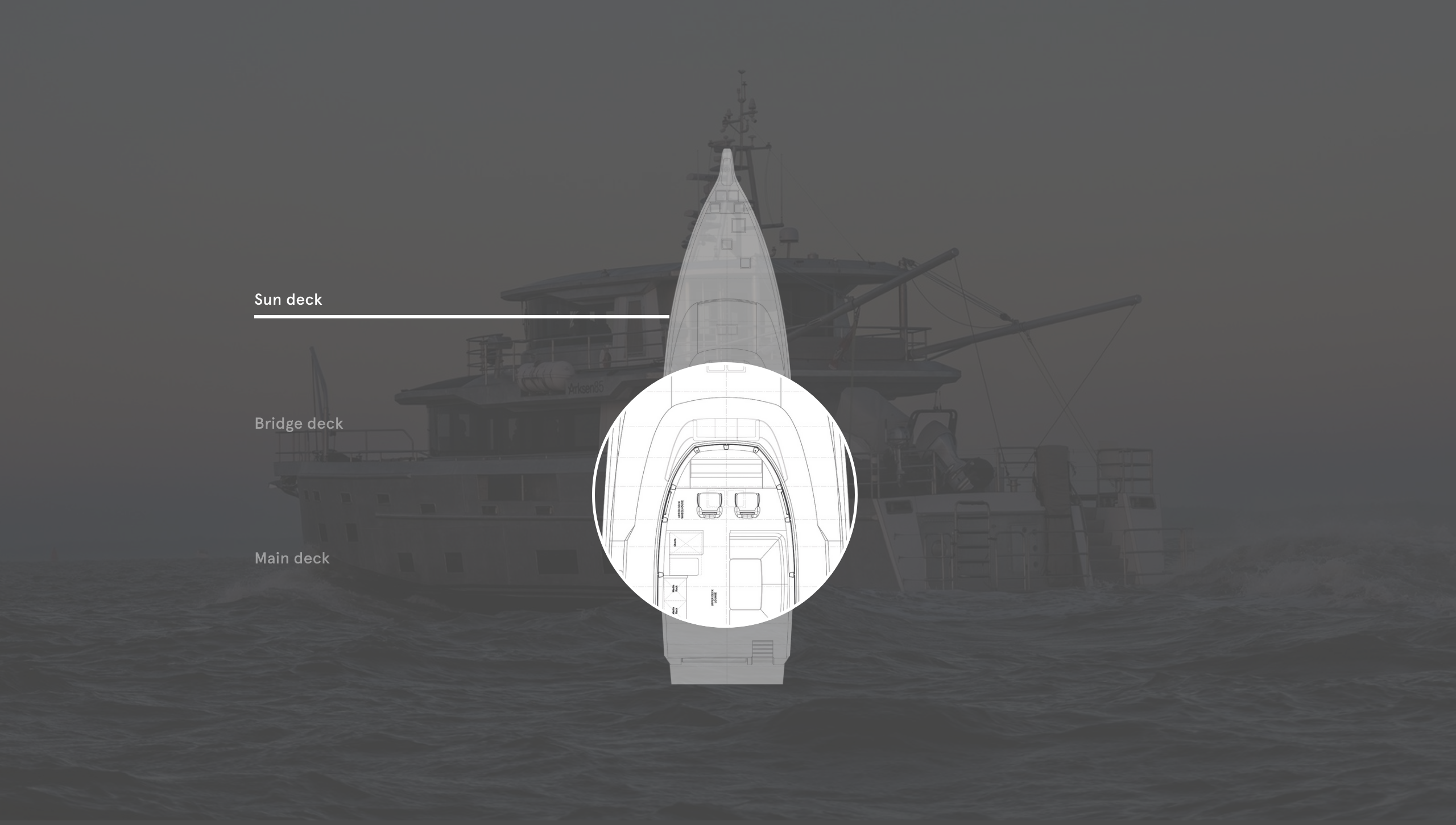
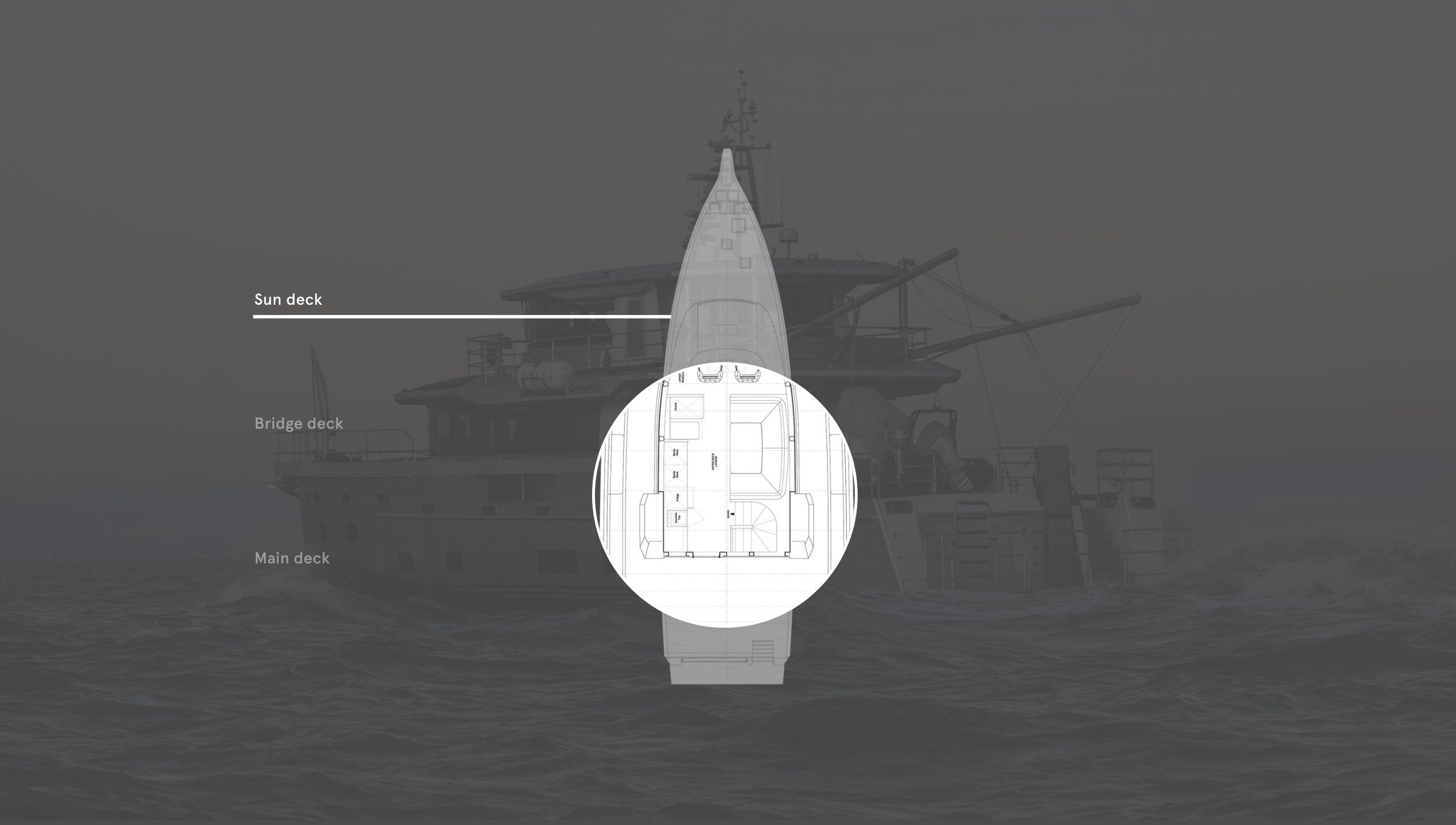
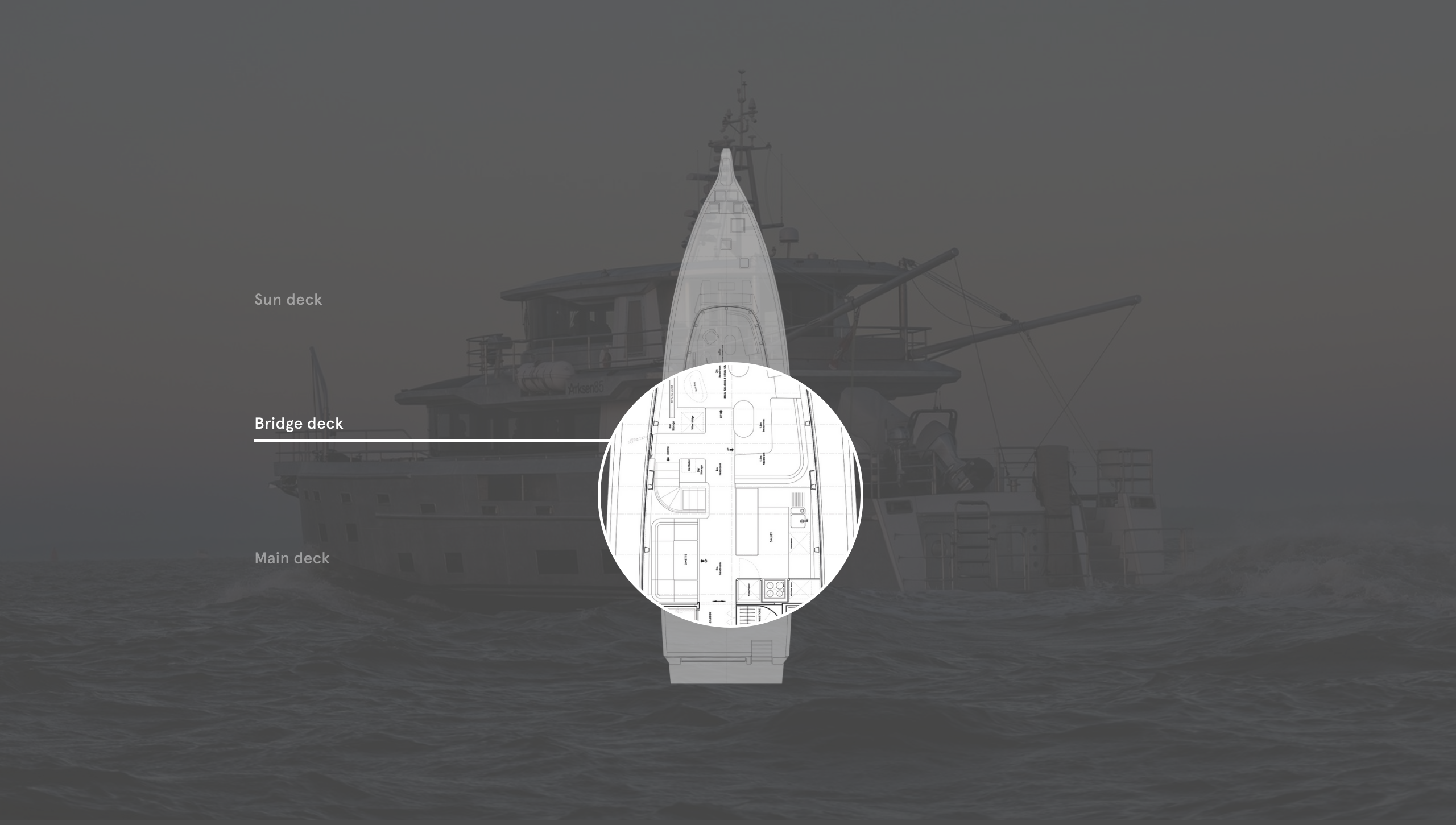
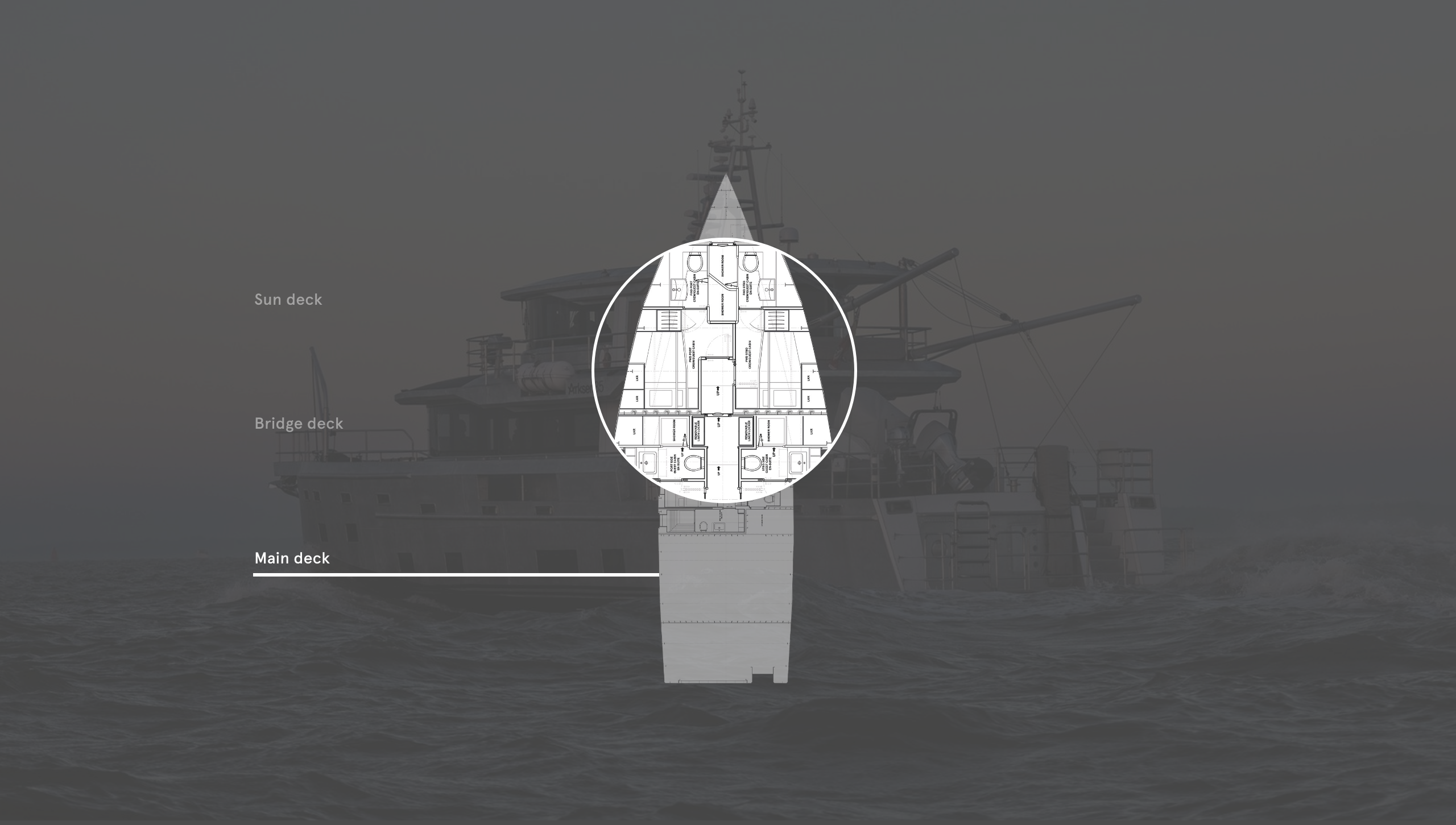
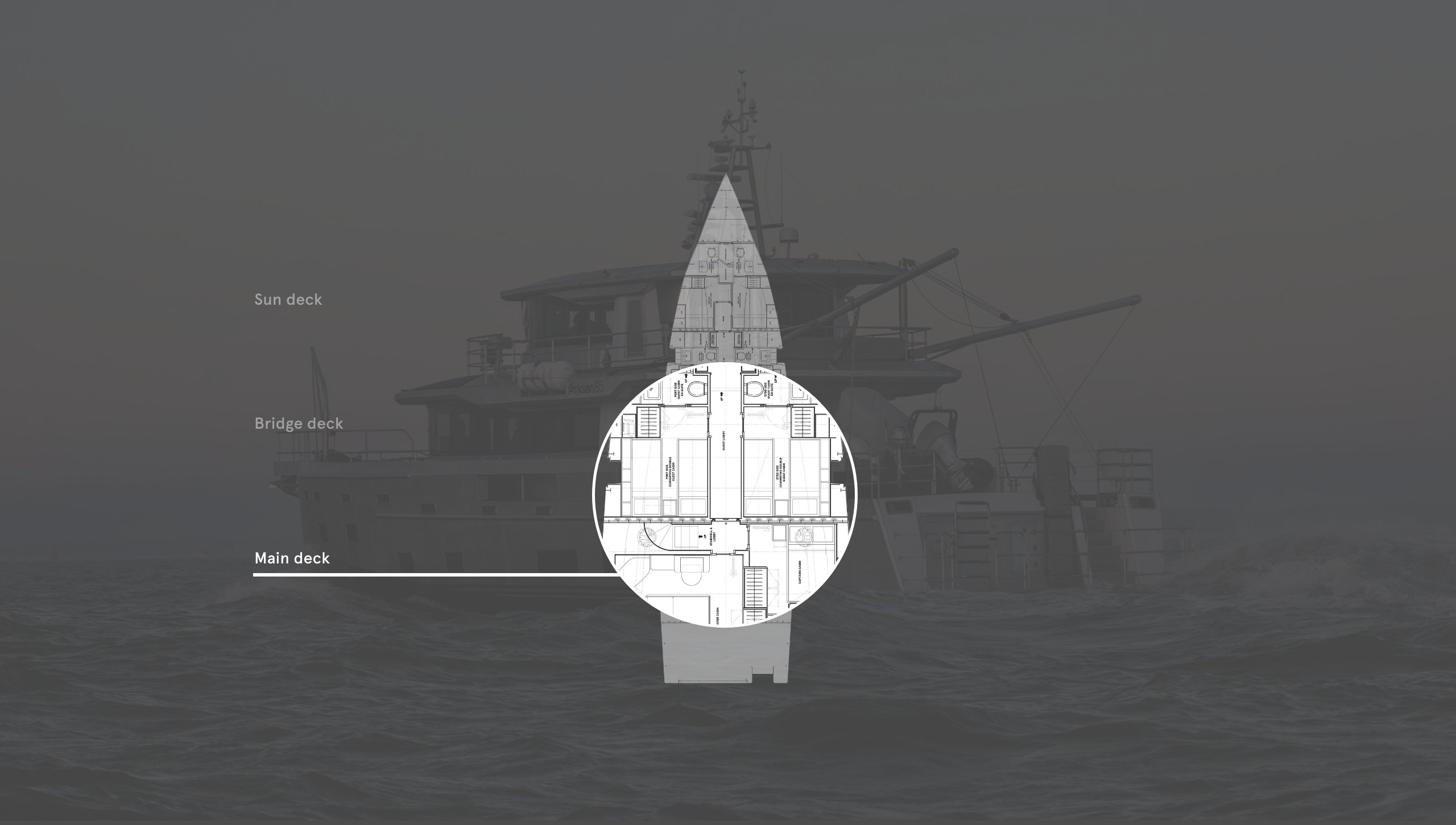
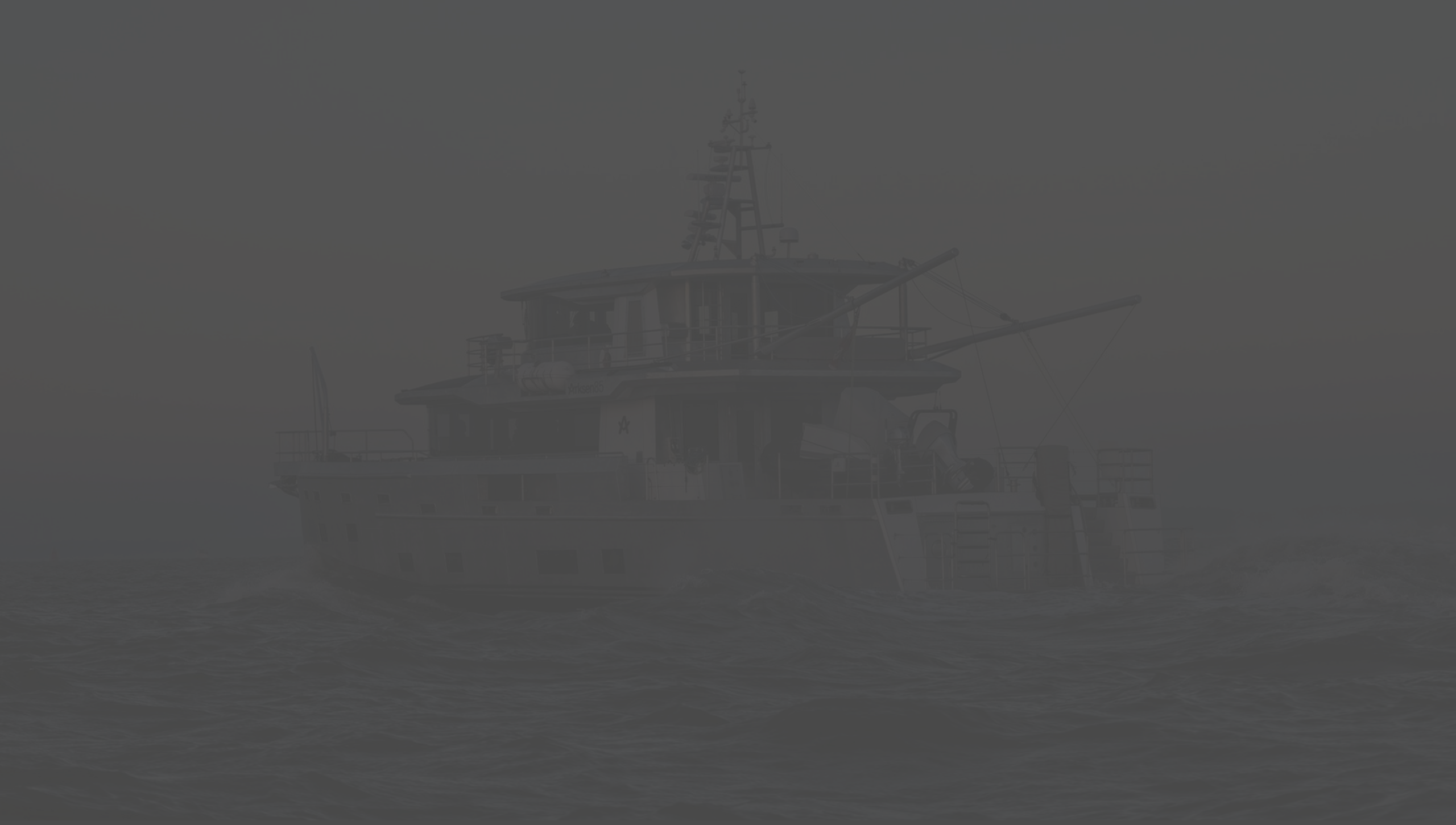
The flybridge boasts 360-degree views
The bridge deck has a full wet bar area to port
The stairwell was moved forward, making for a larger main-deck saloon
The forward cabins can be used for guests or crew
Watertight subdivisions in the hull add extra safety
LOA 27.4m | Gross tonnage |
LWL 26.06m | Engines |
Beam 7m | Generators |
Draught 1.55m | Speed (max/cruise) |
Range at 9 knots | Tender |
Fuel capacity | Owners/guests 10 |
Freshwater capacity | Crew 2 |
Classification | Construction |
Naval architecture | Builder/year |
Exterior styling | +44 23 8001 0017 sales@arksen.com arksen.com |
Interior design |


